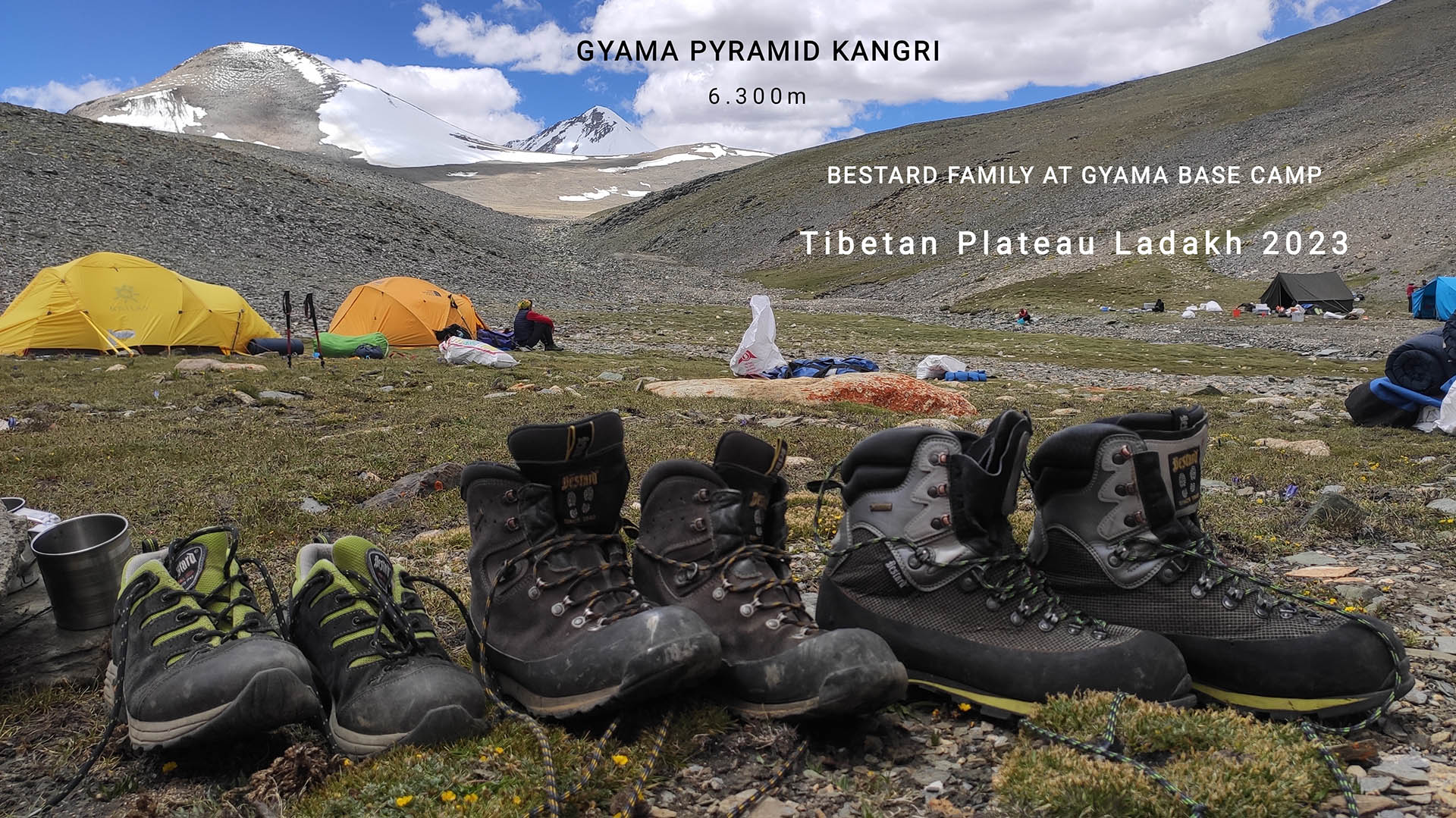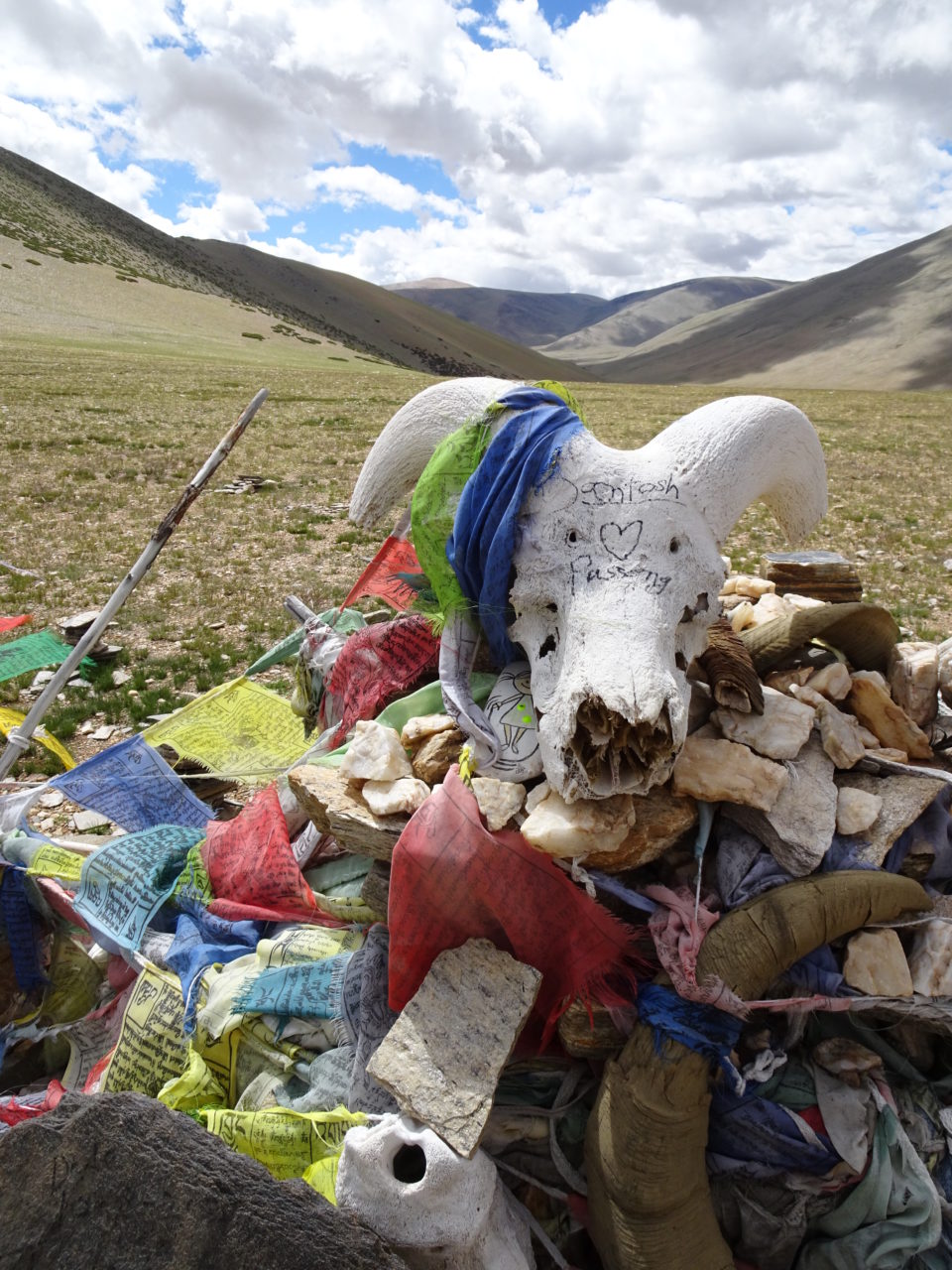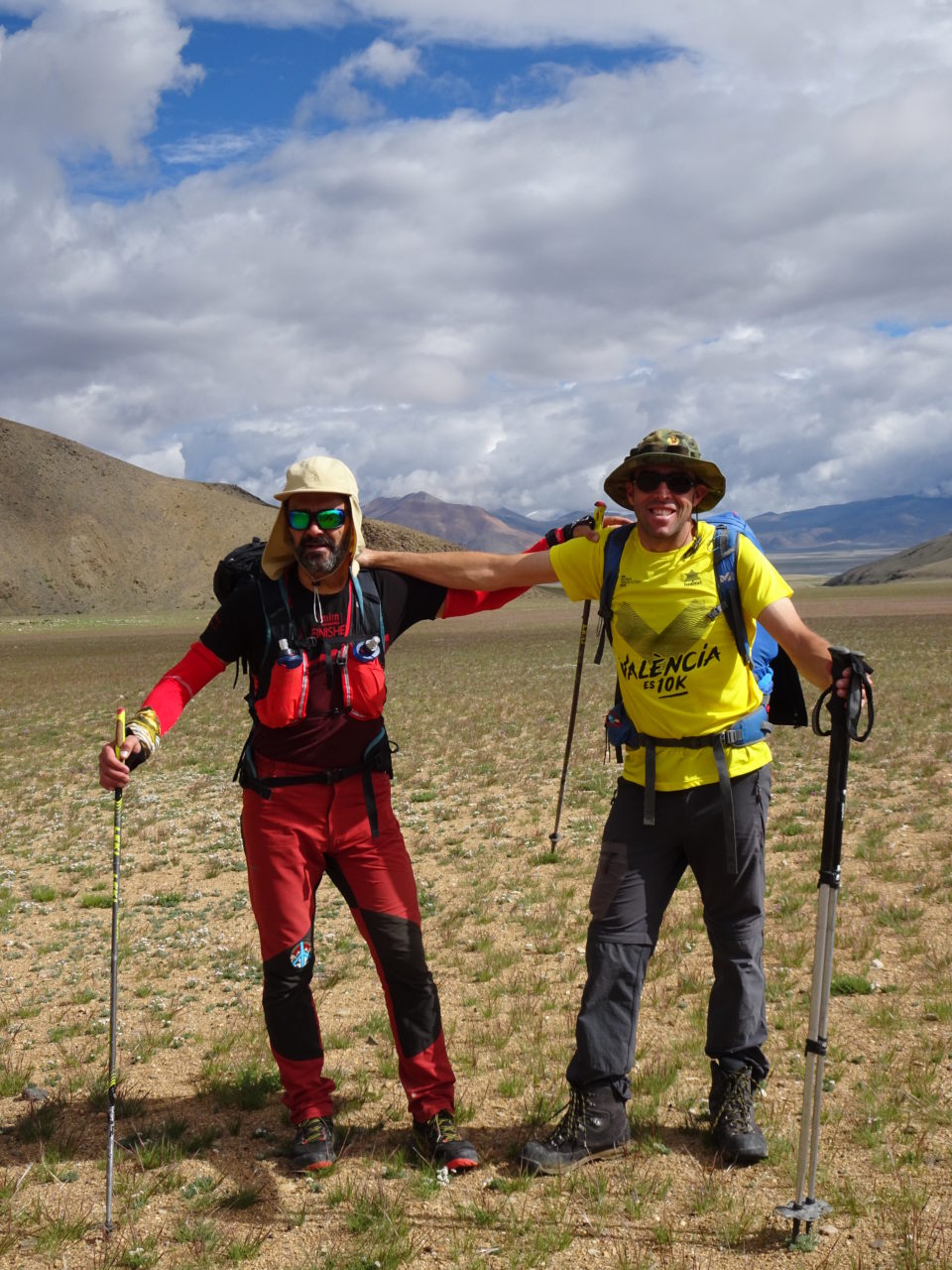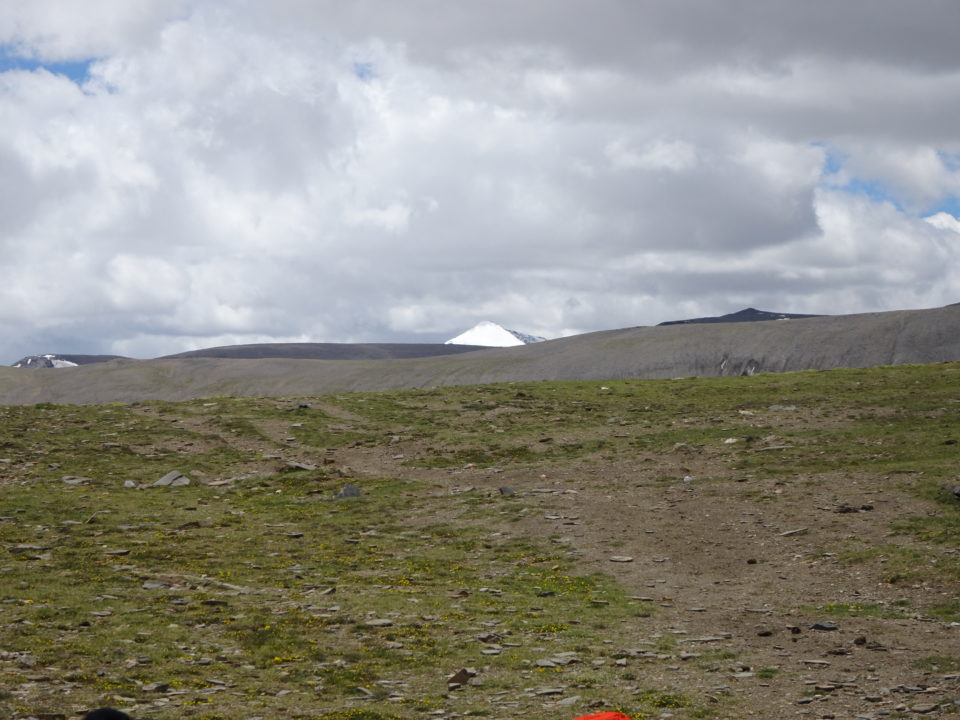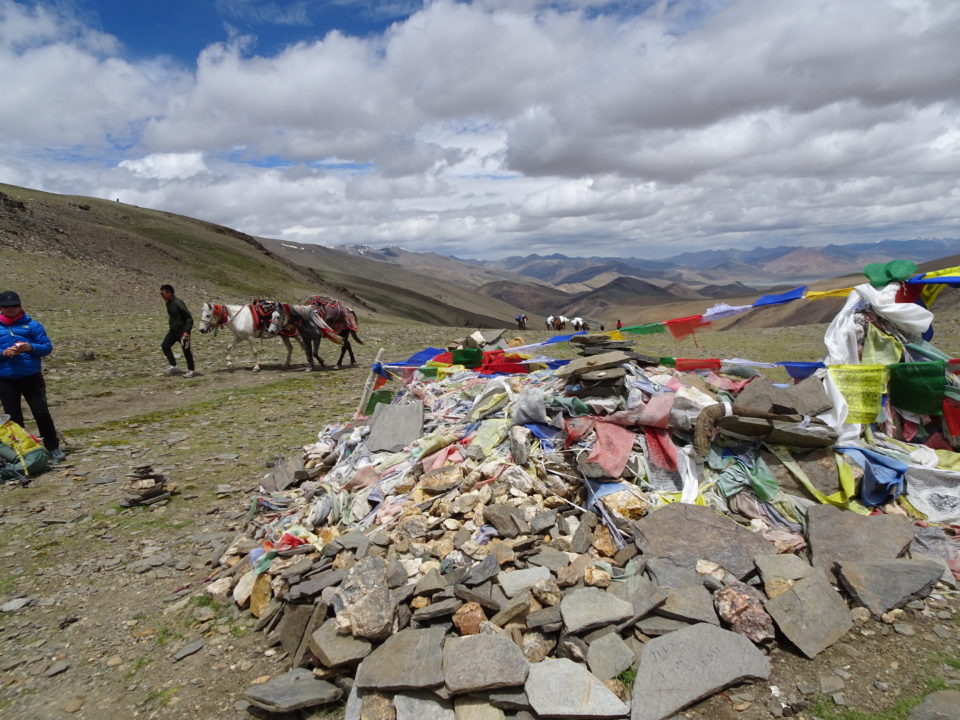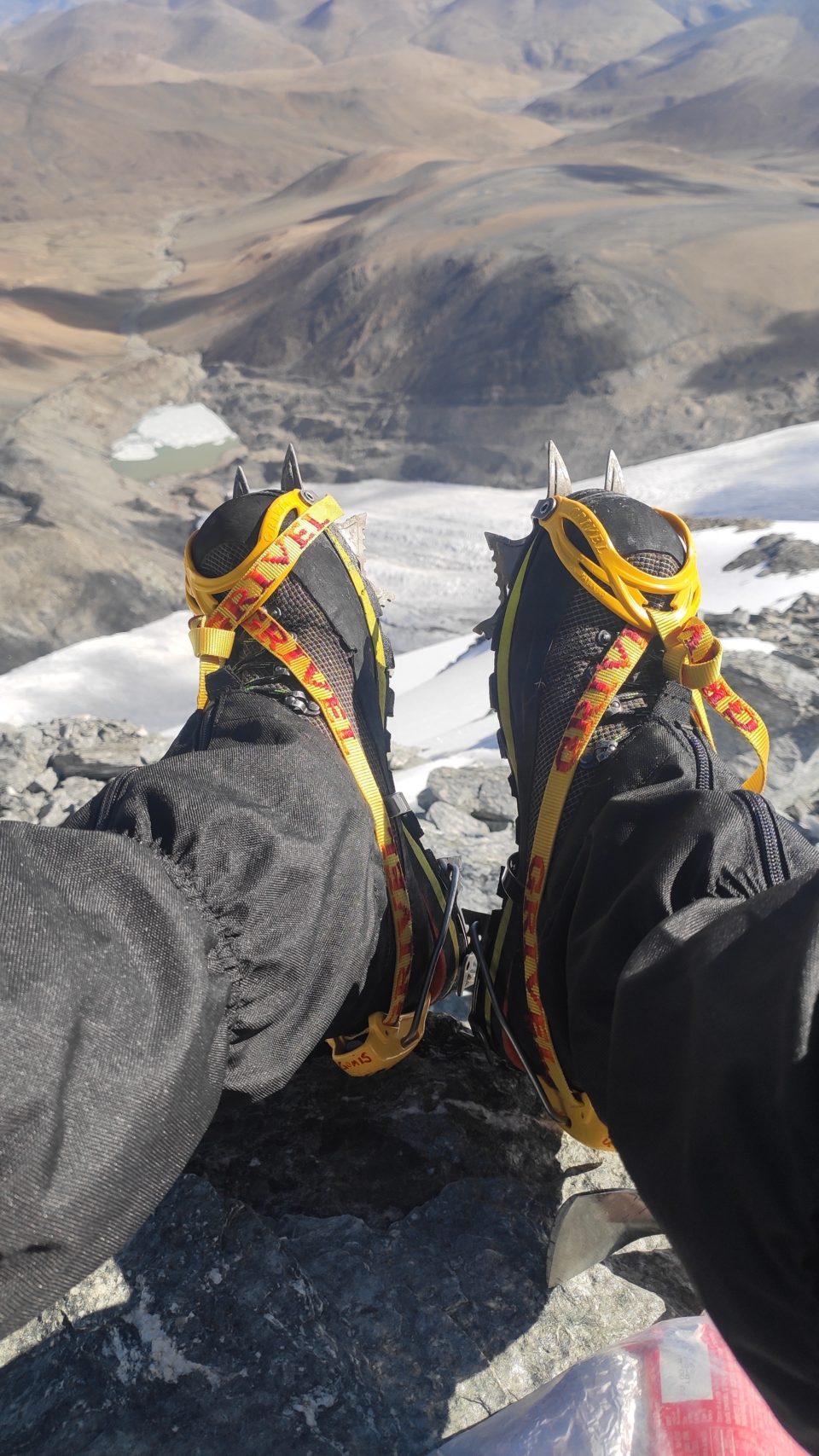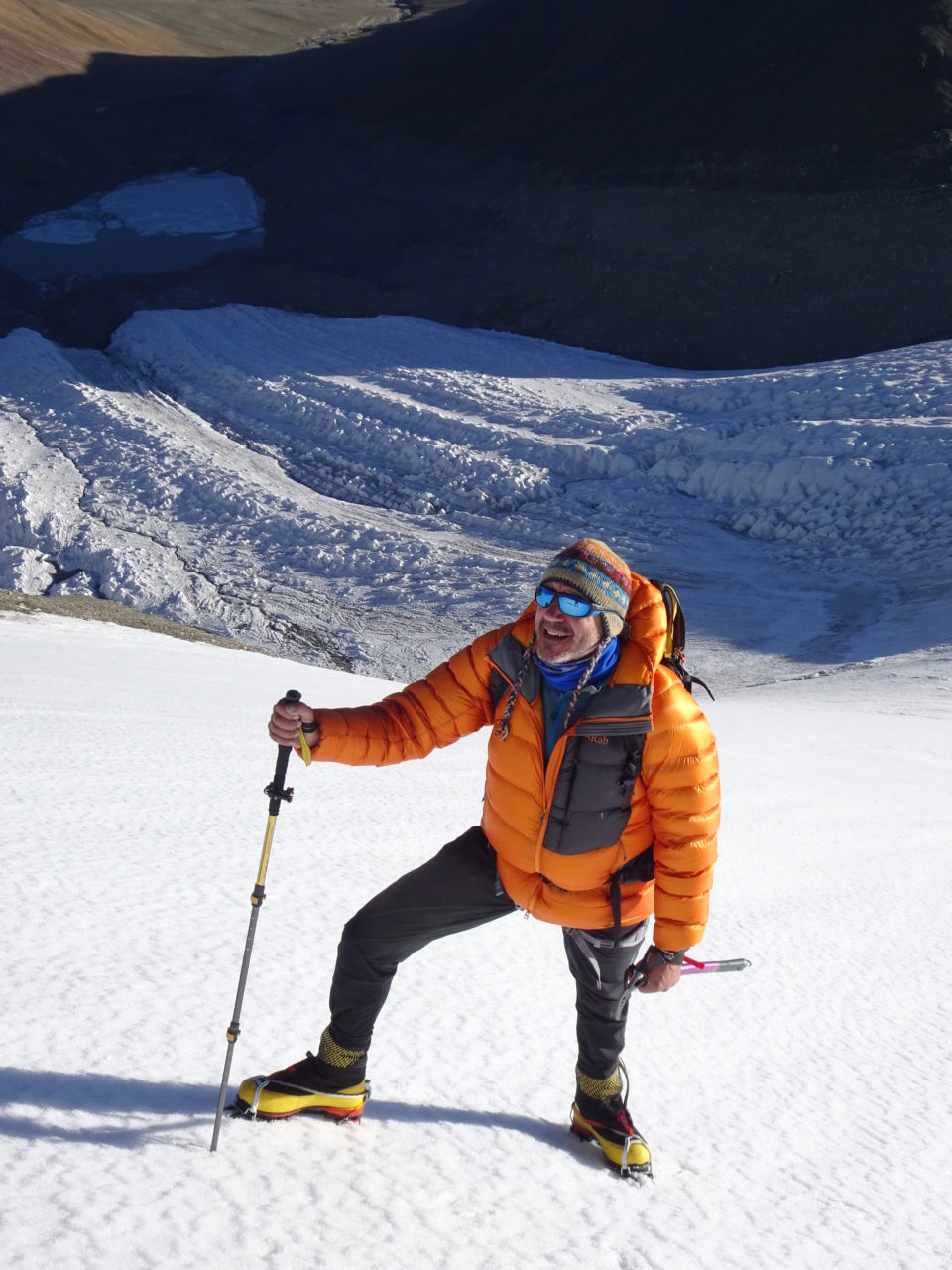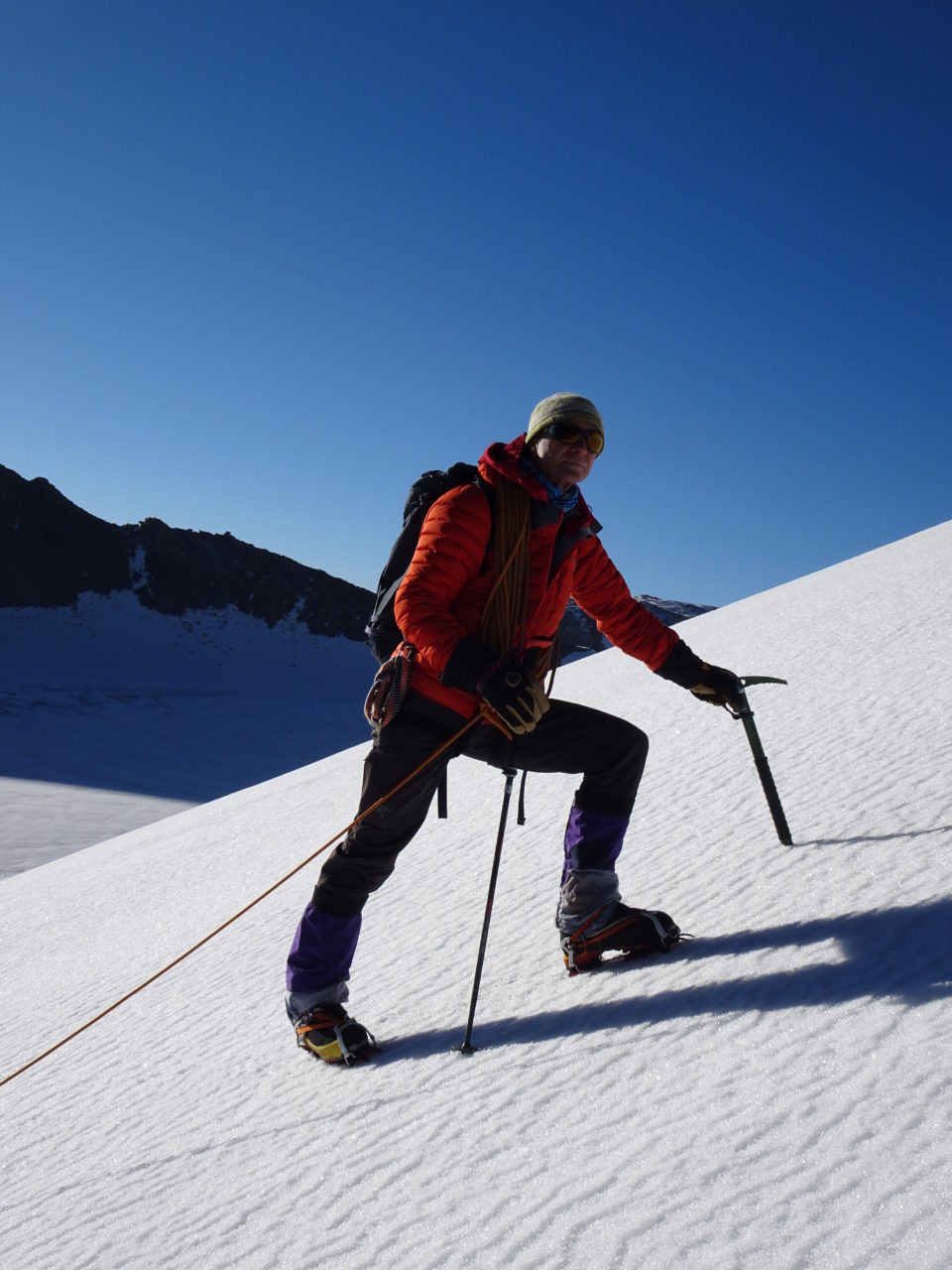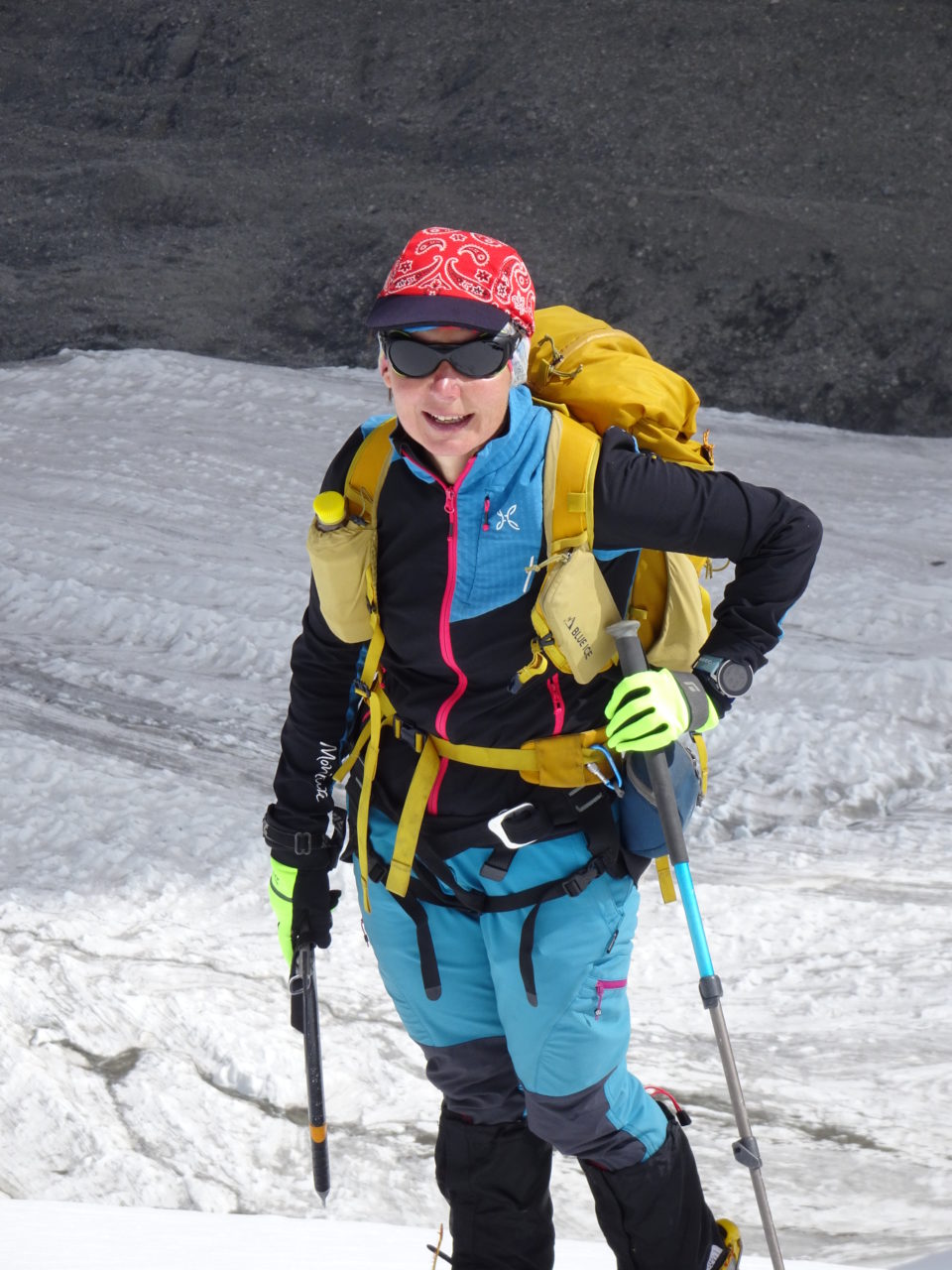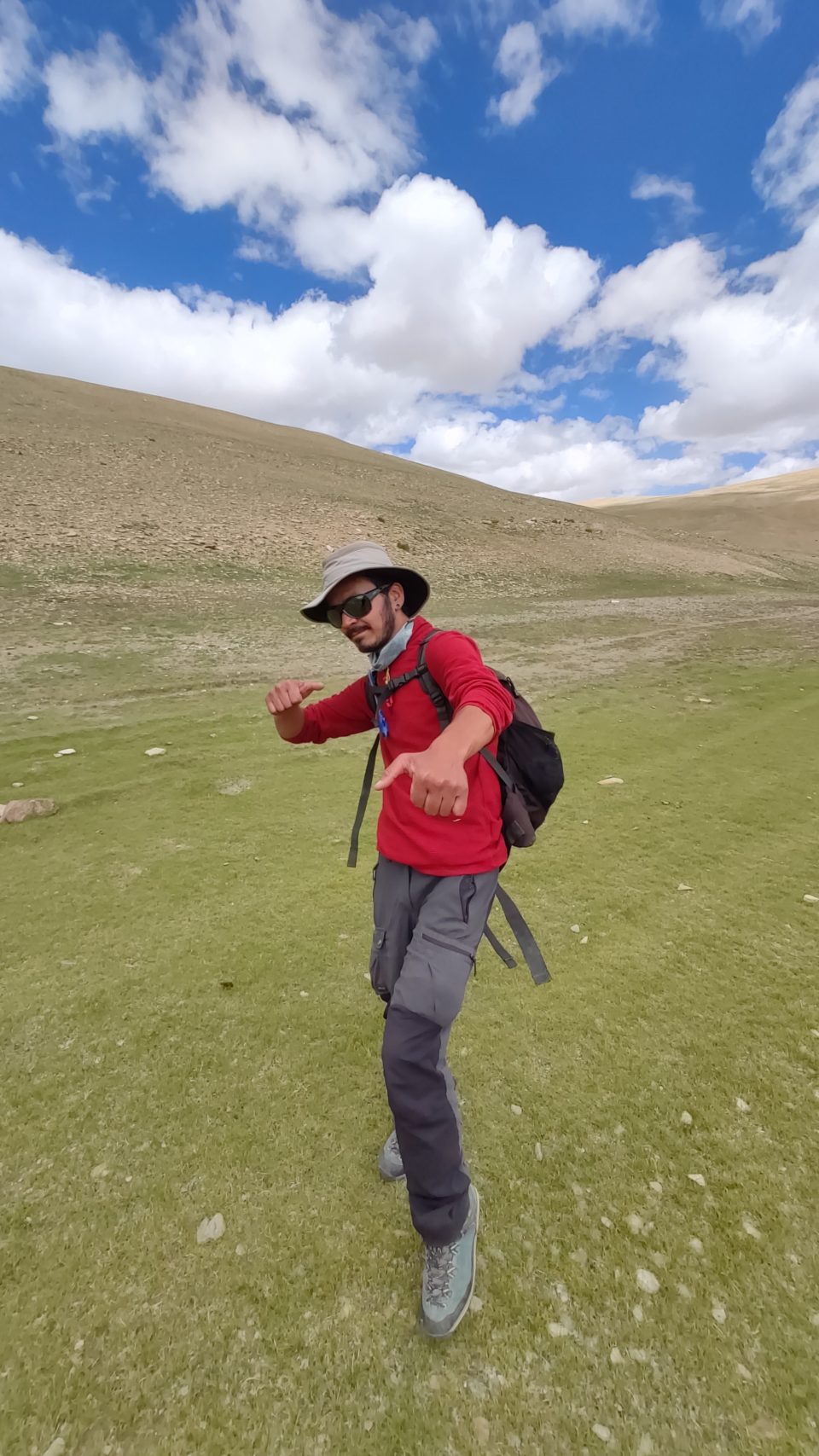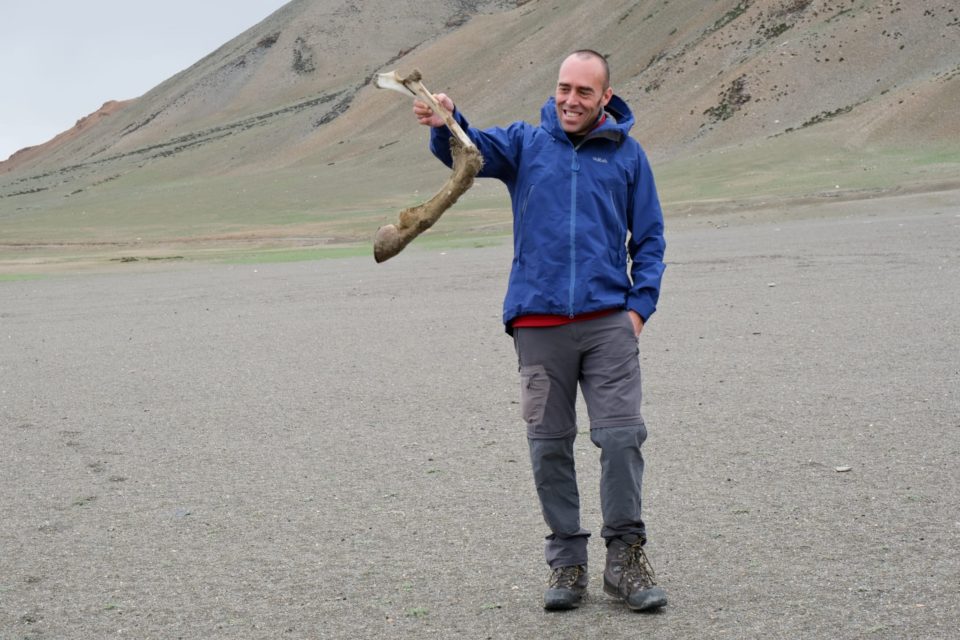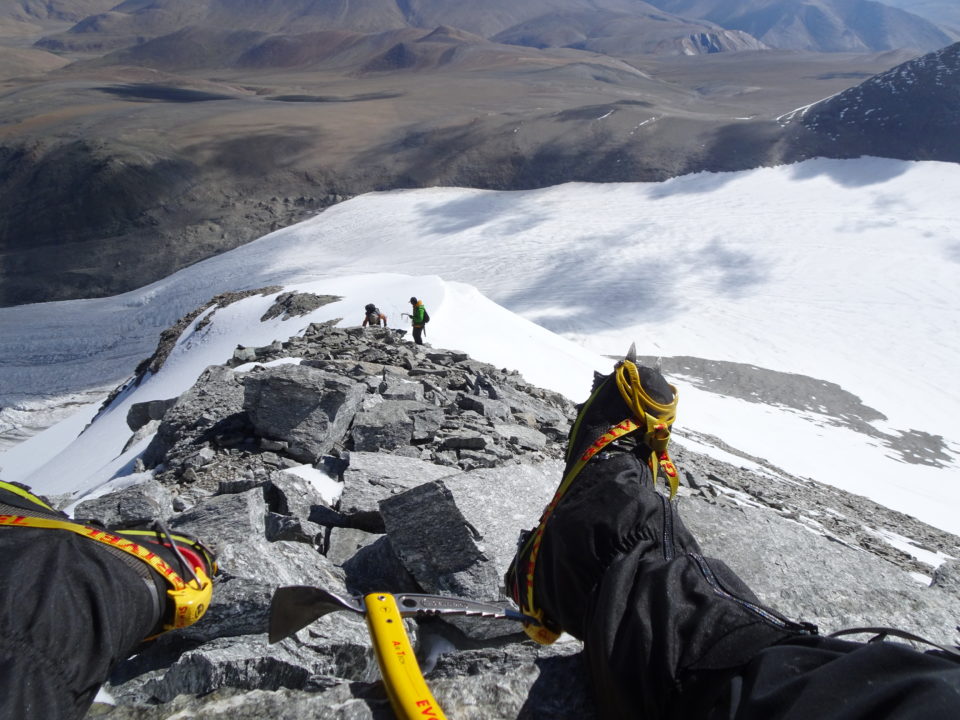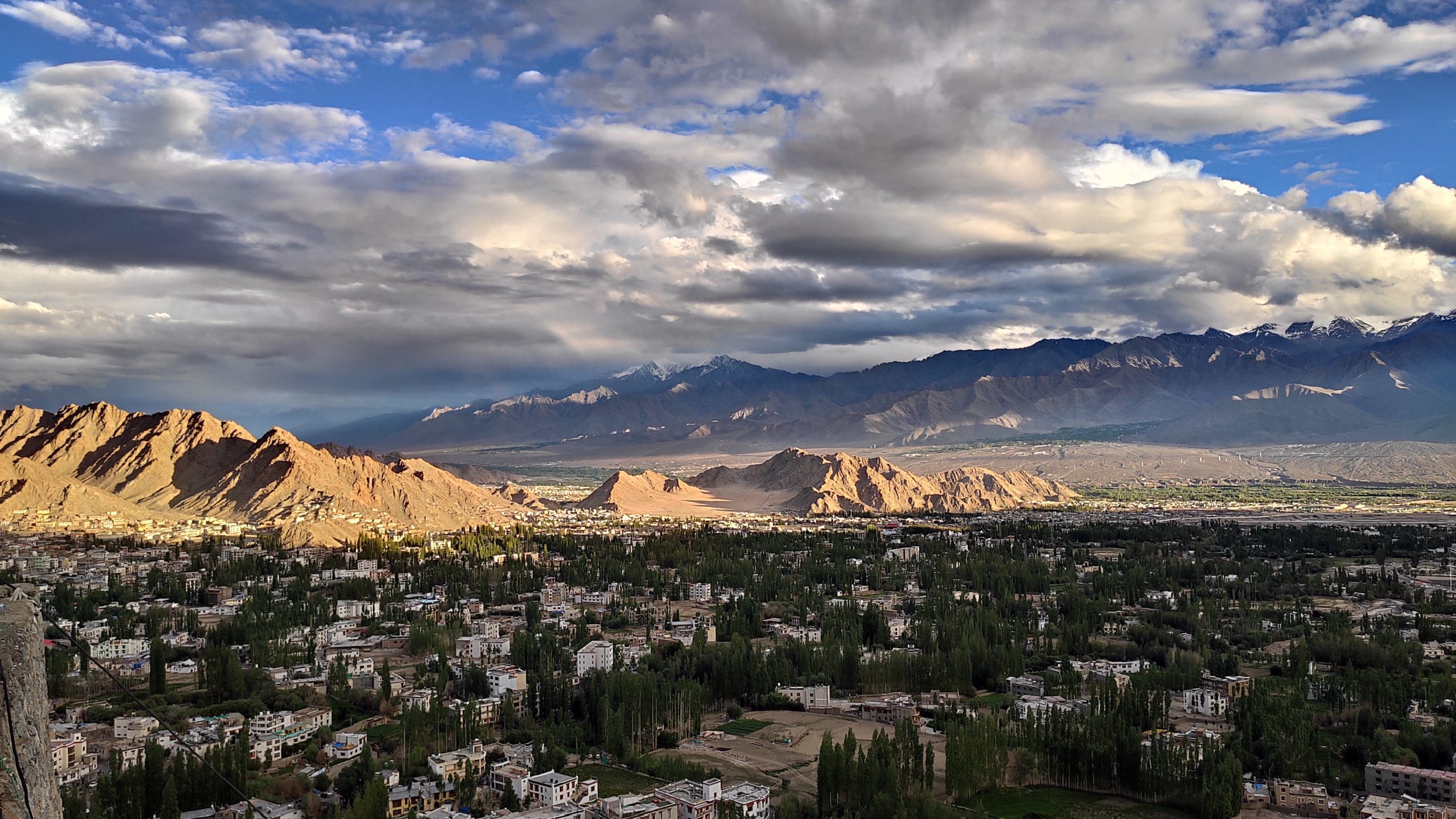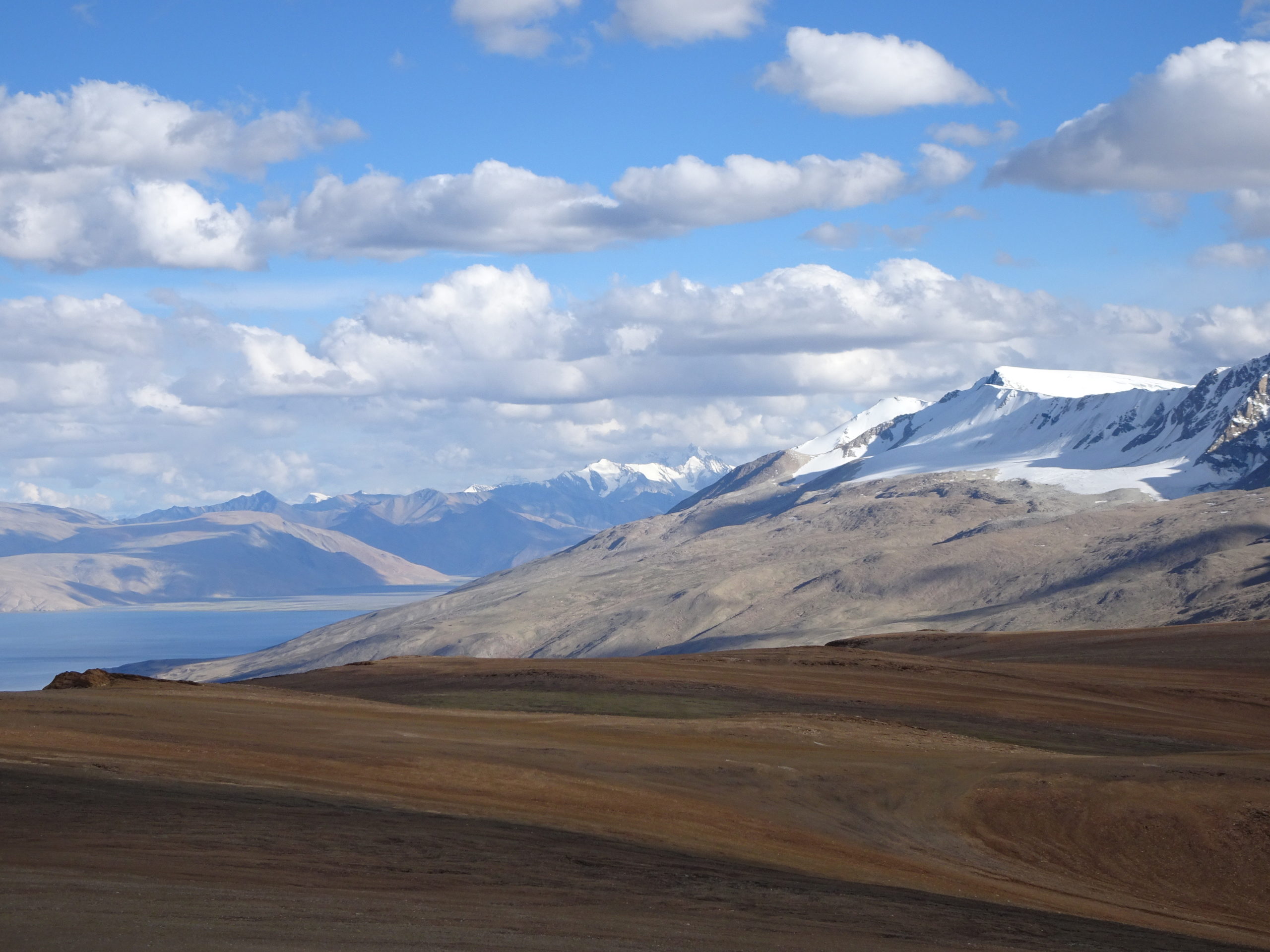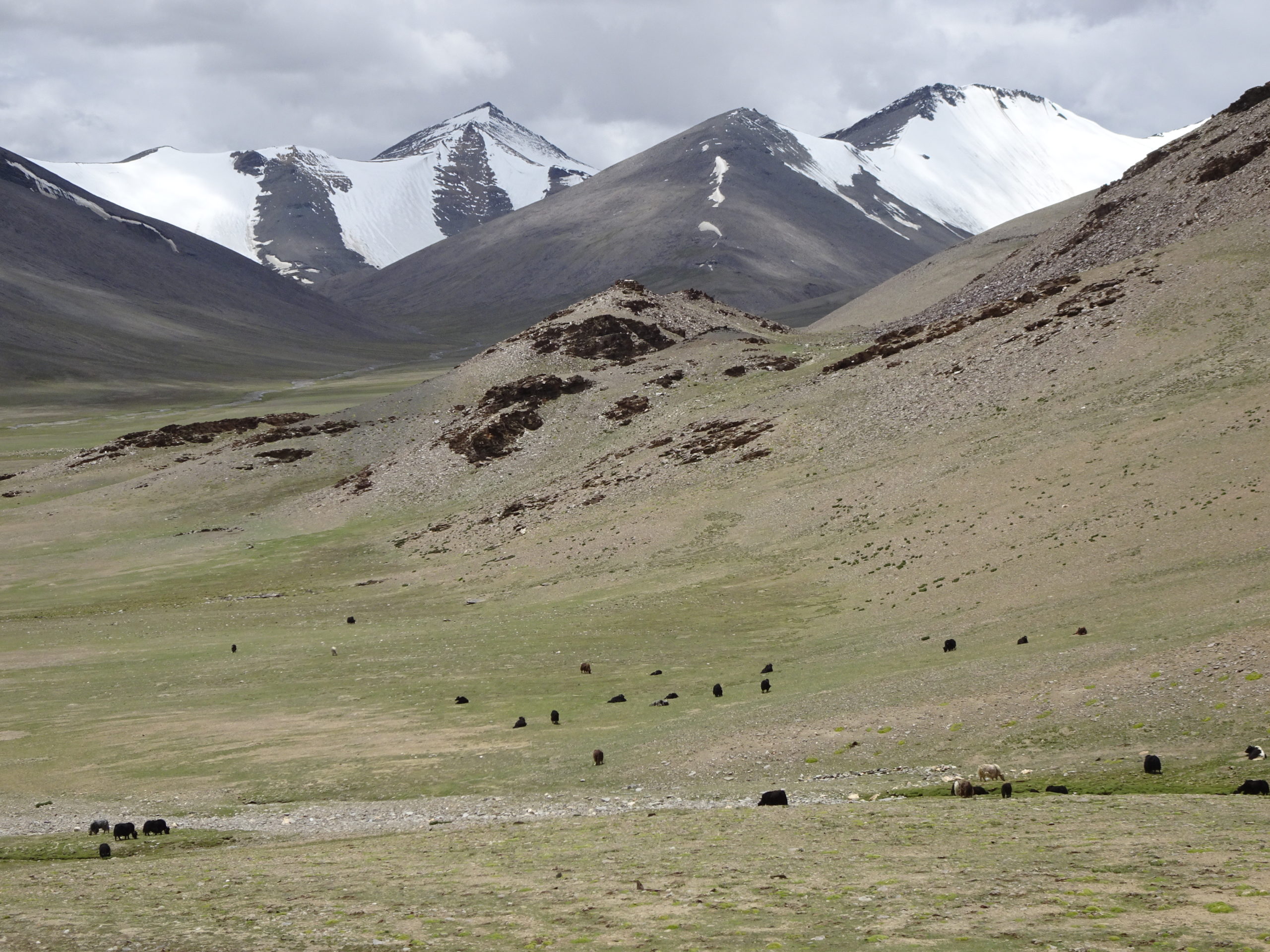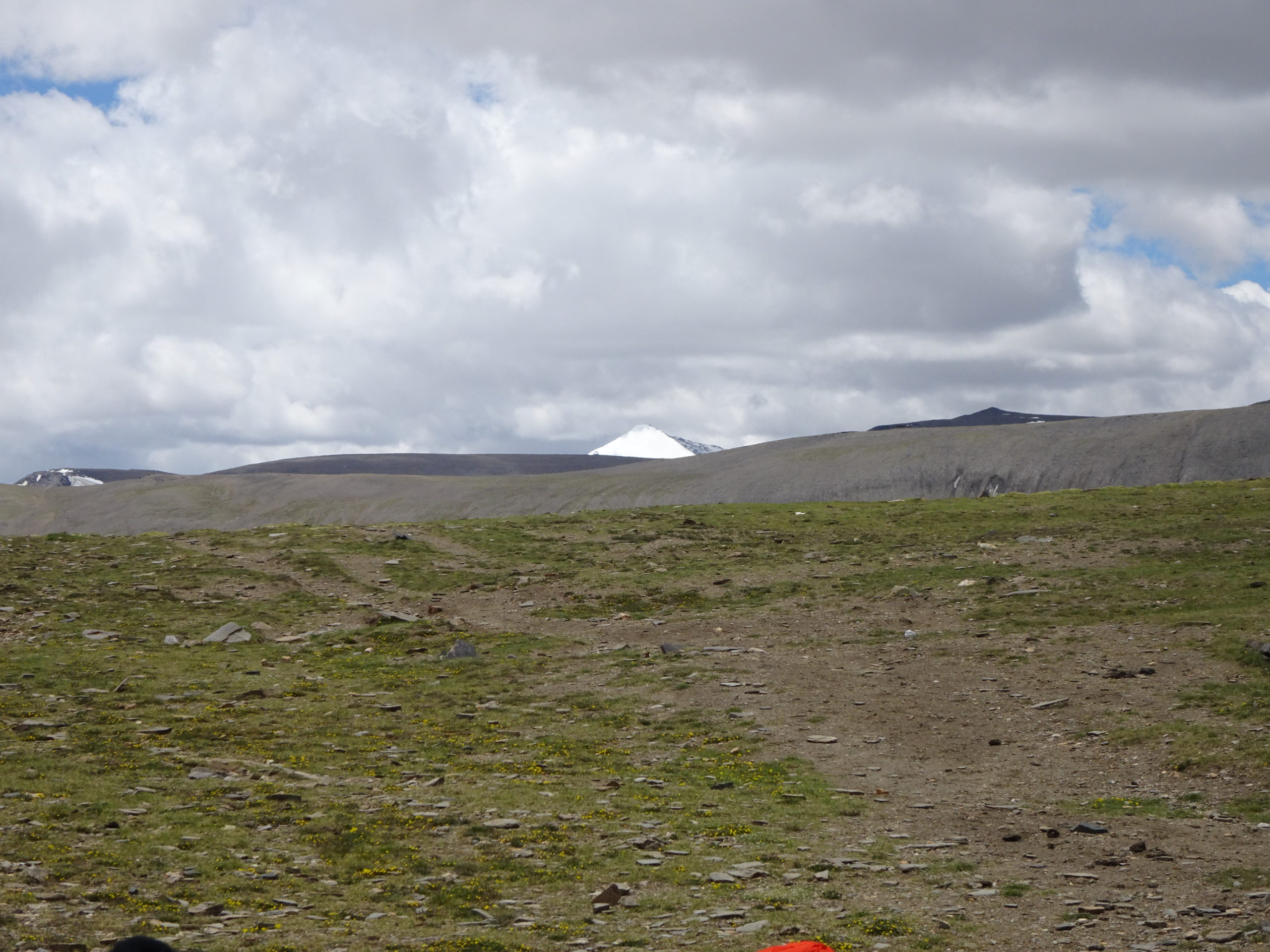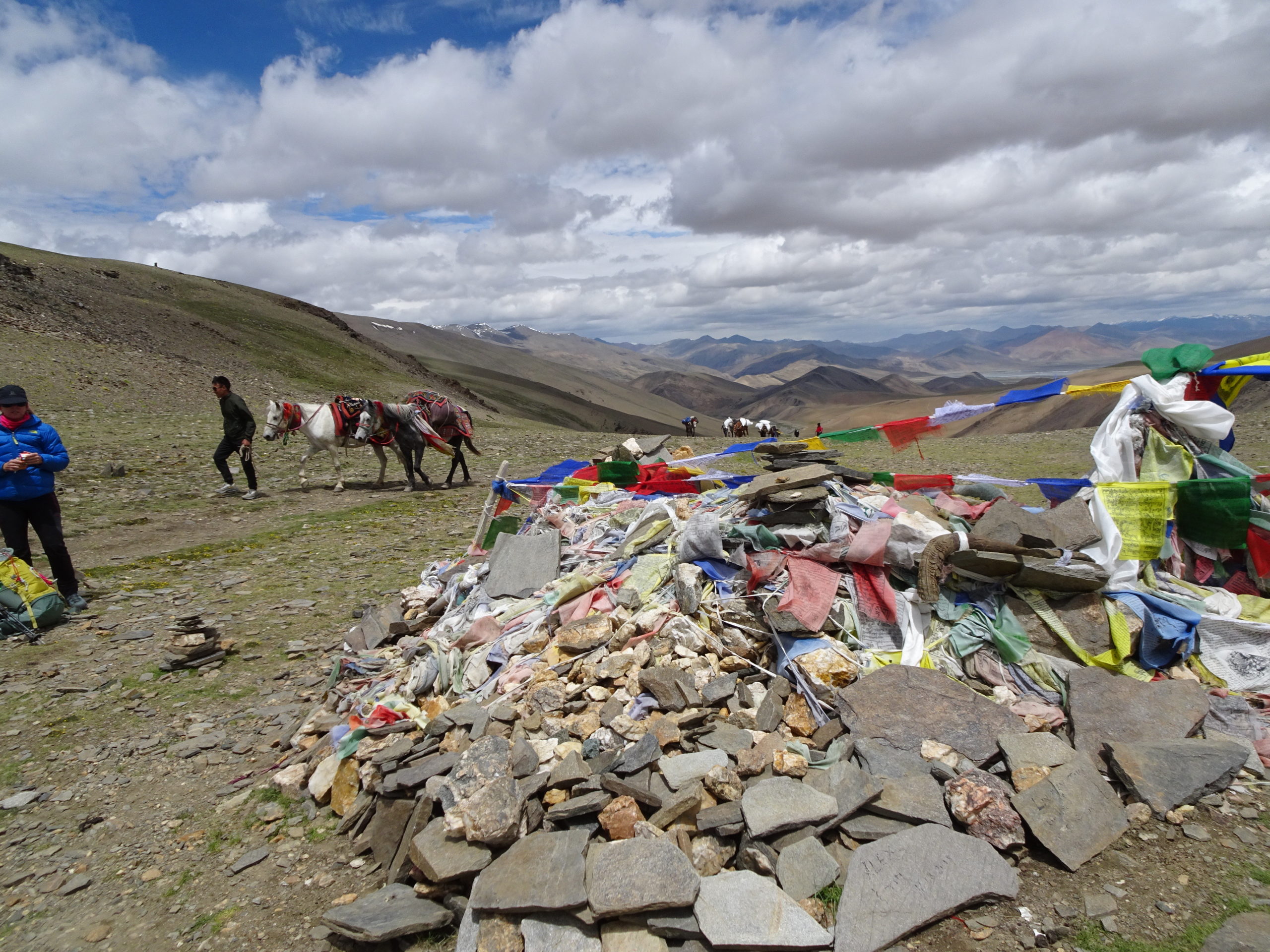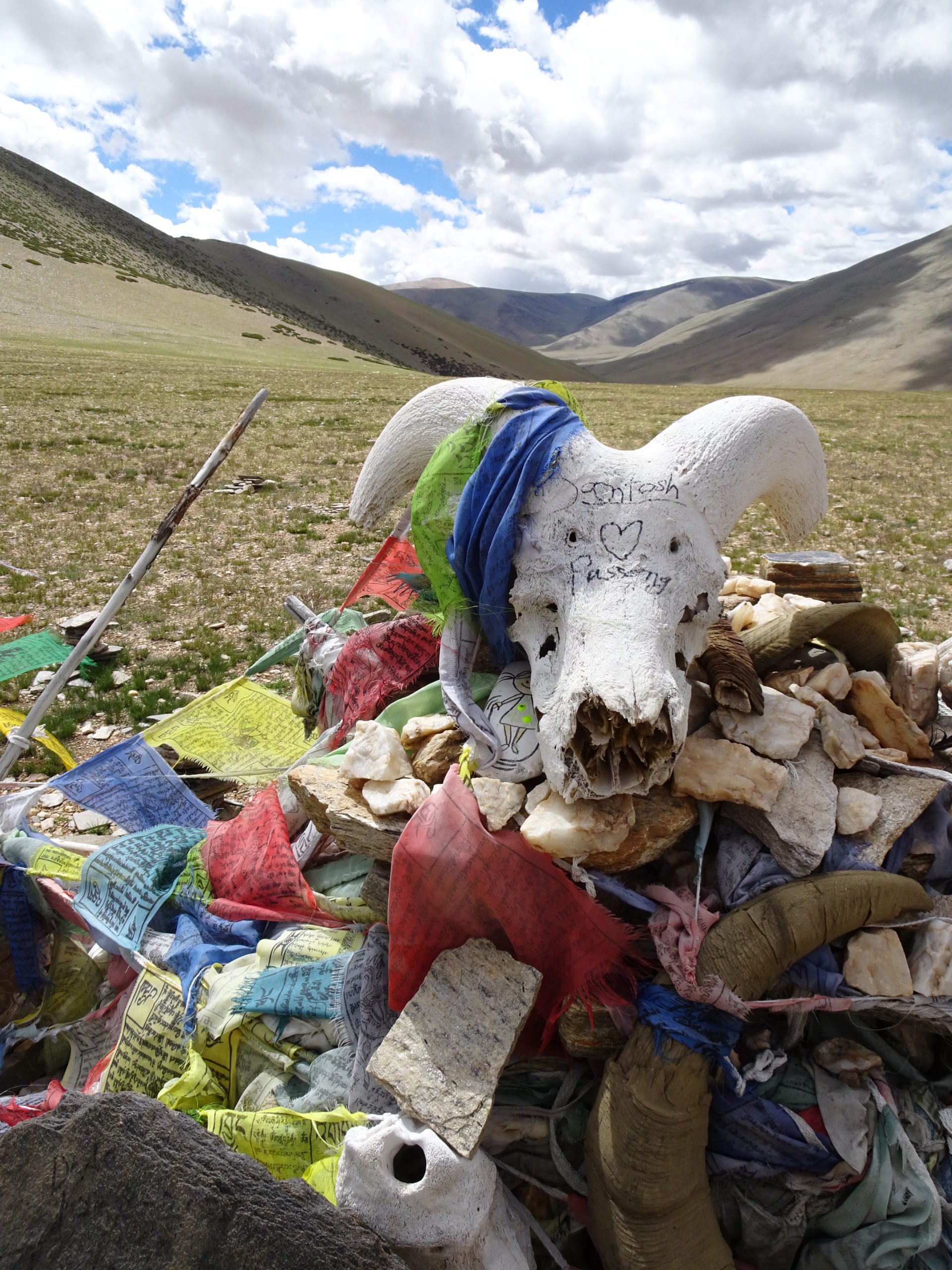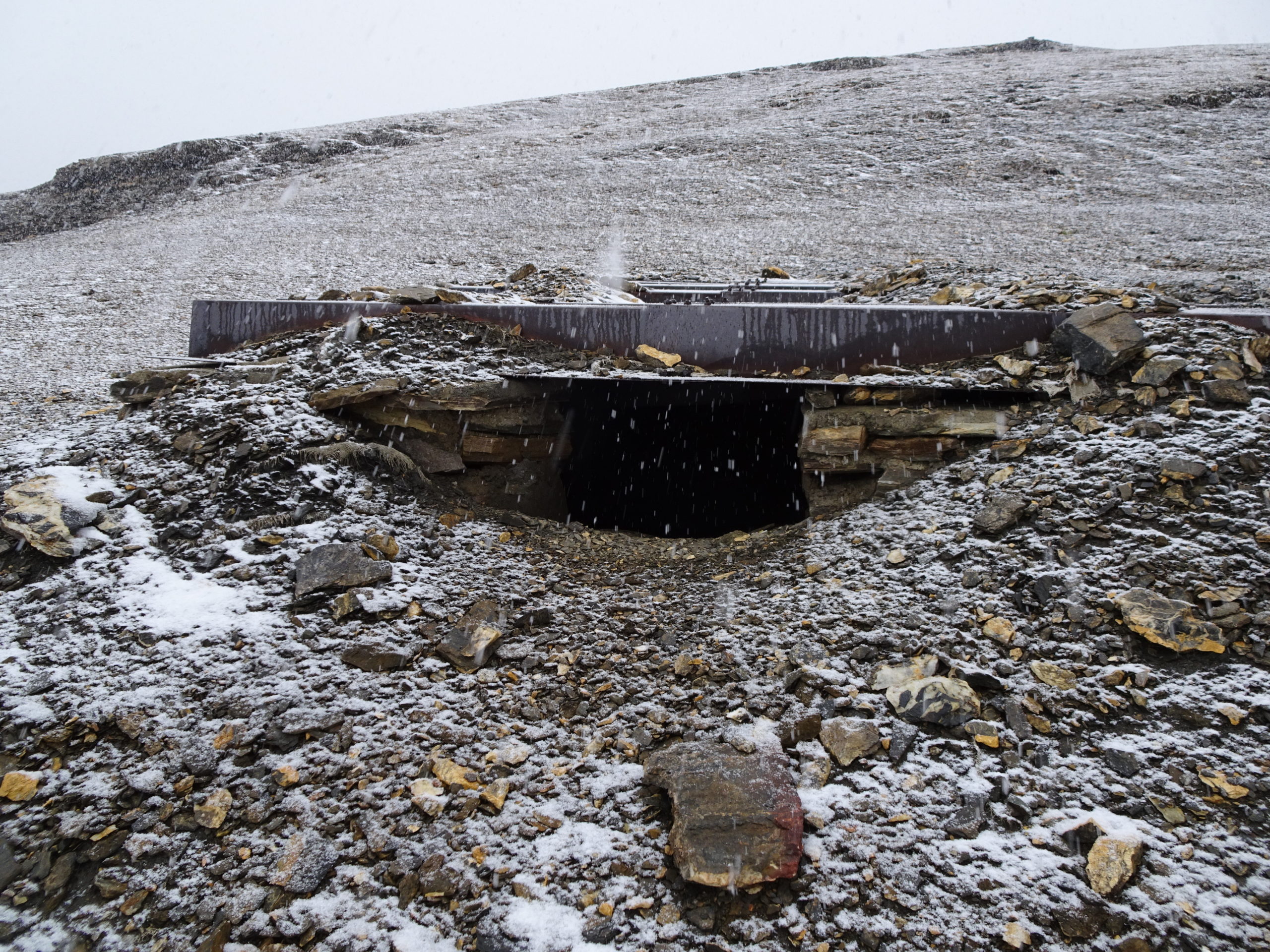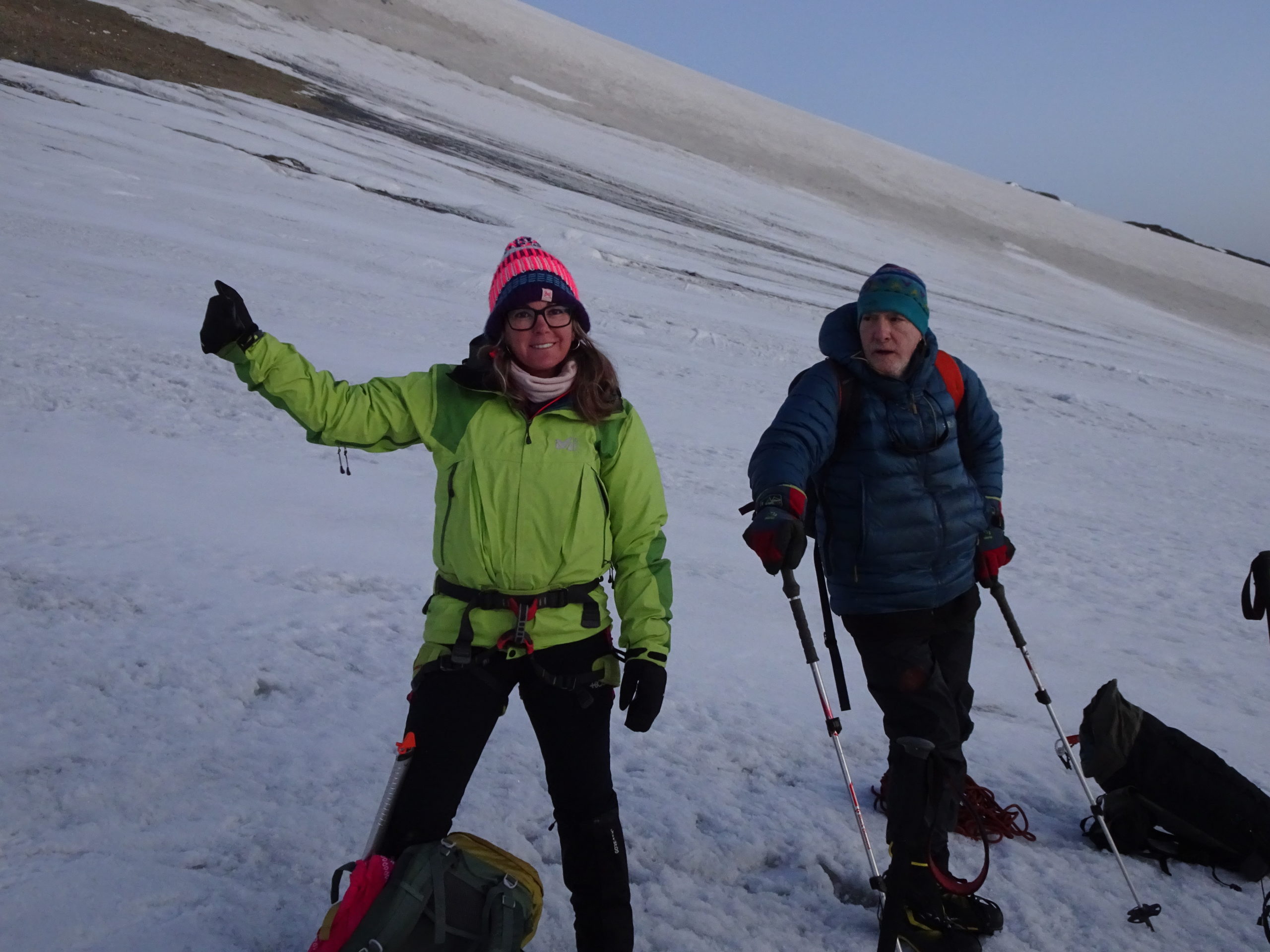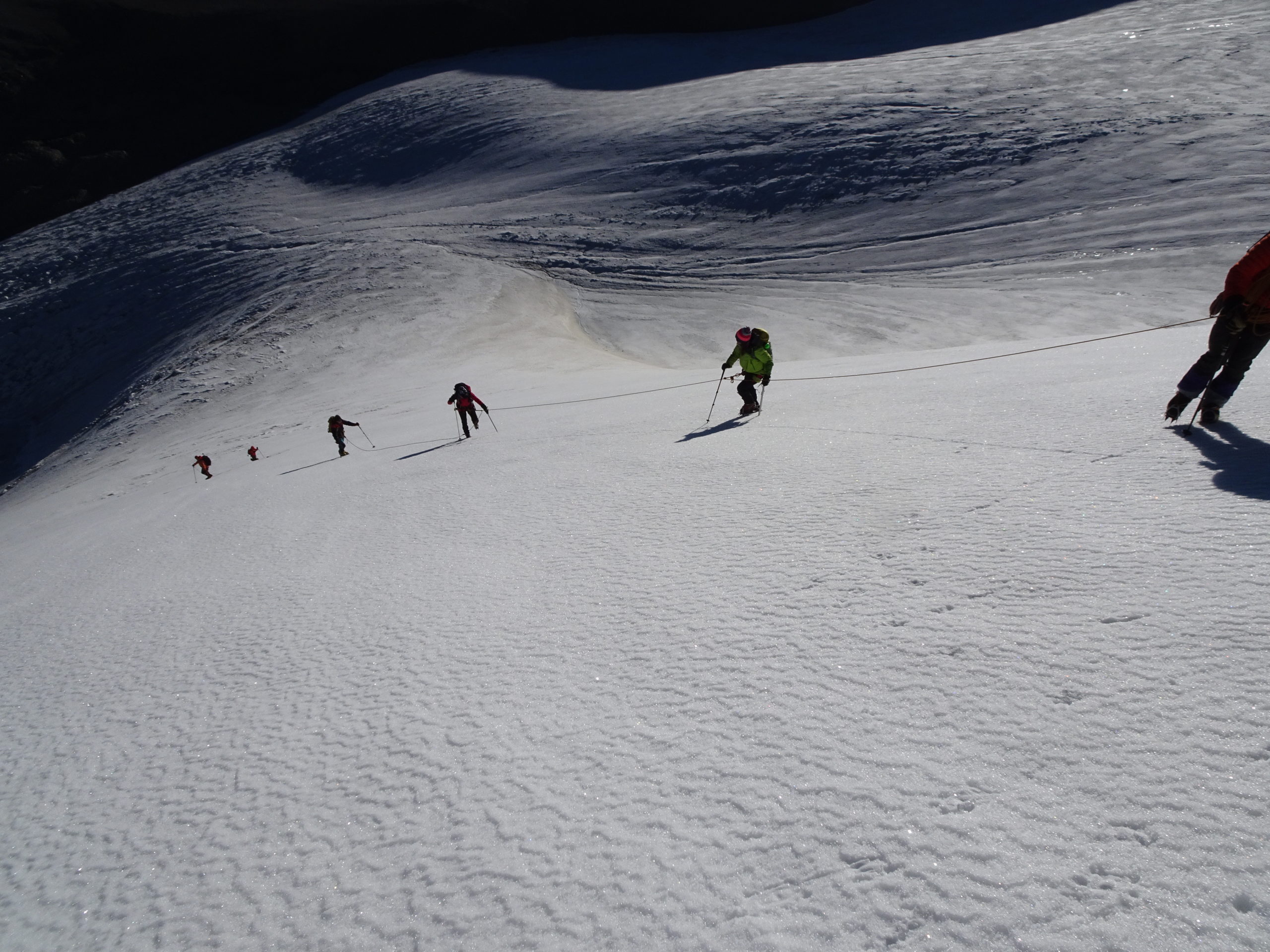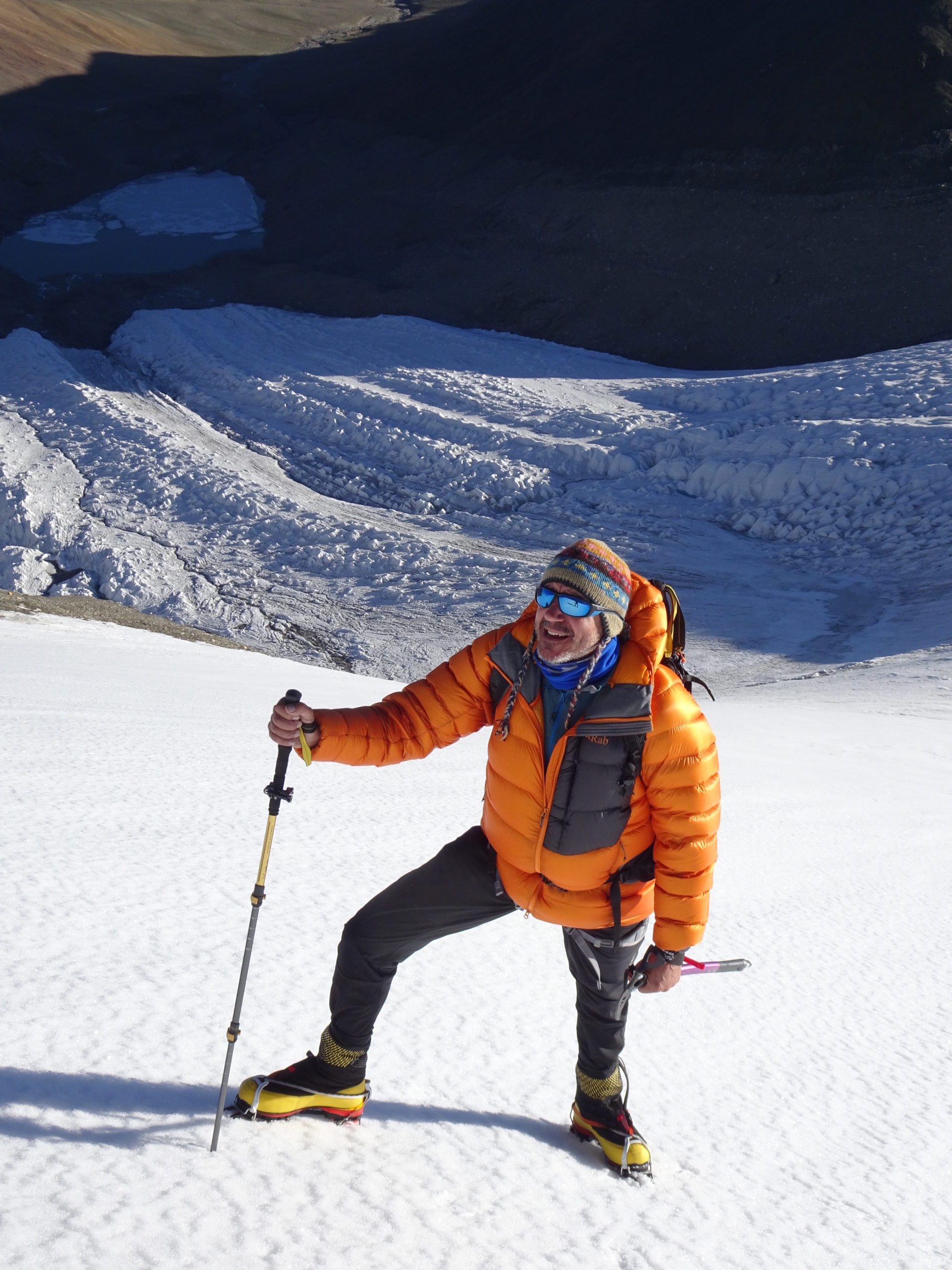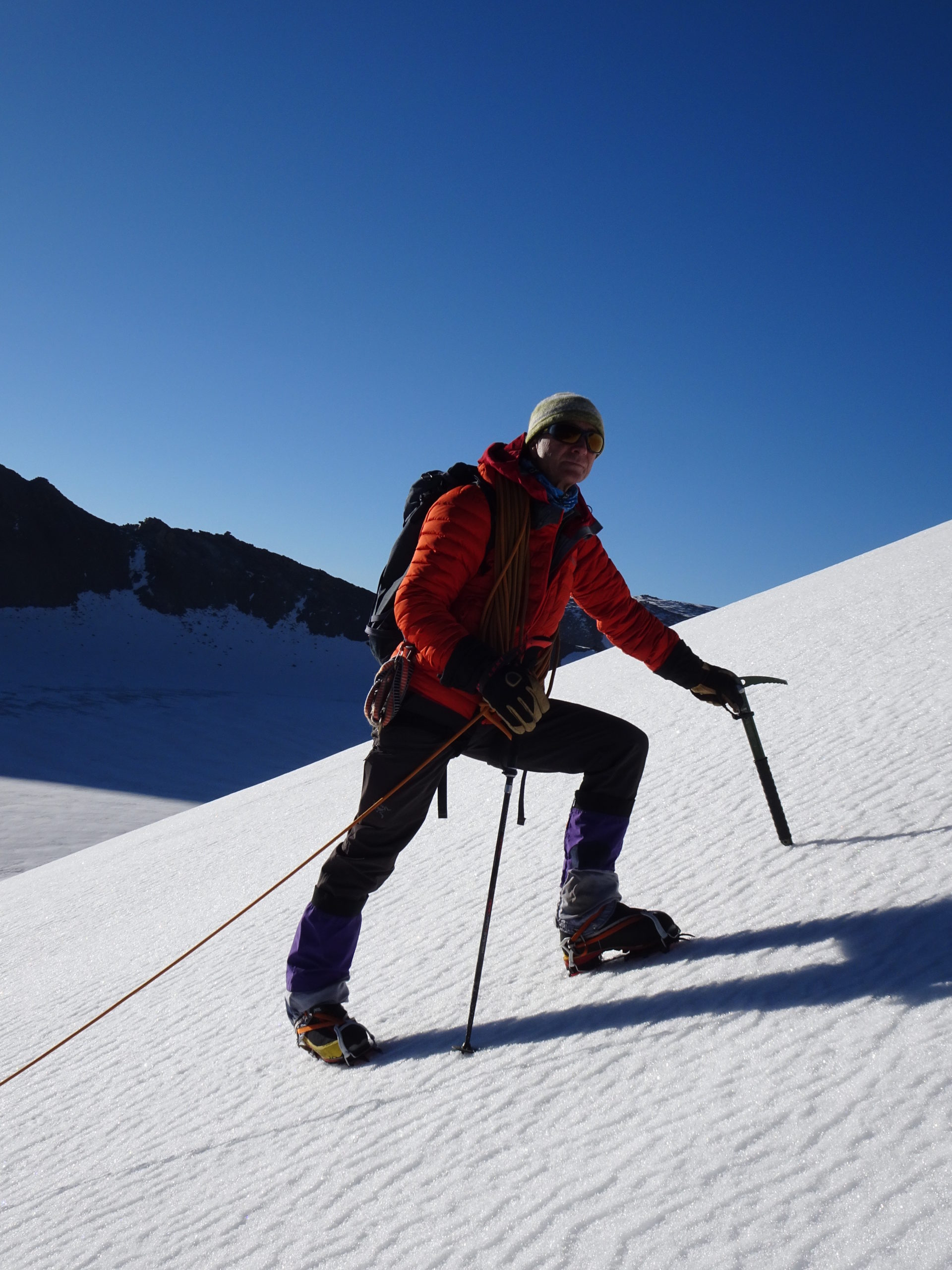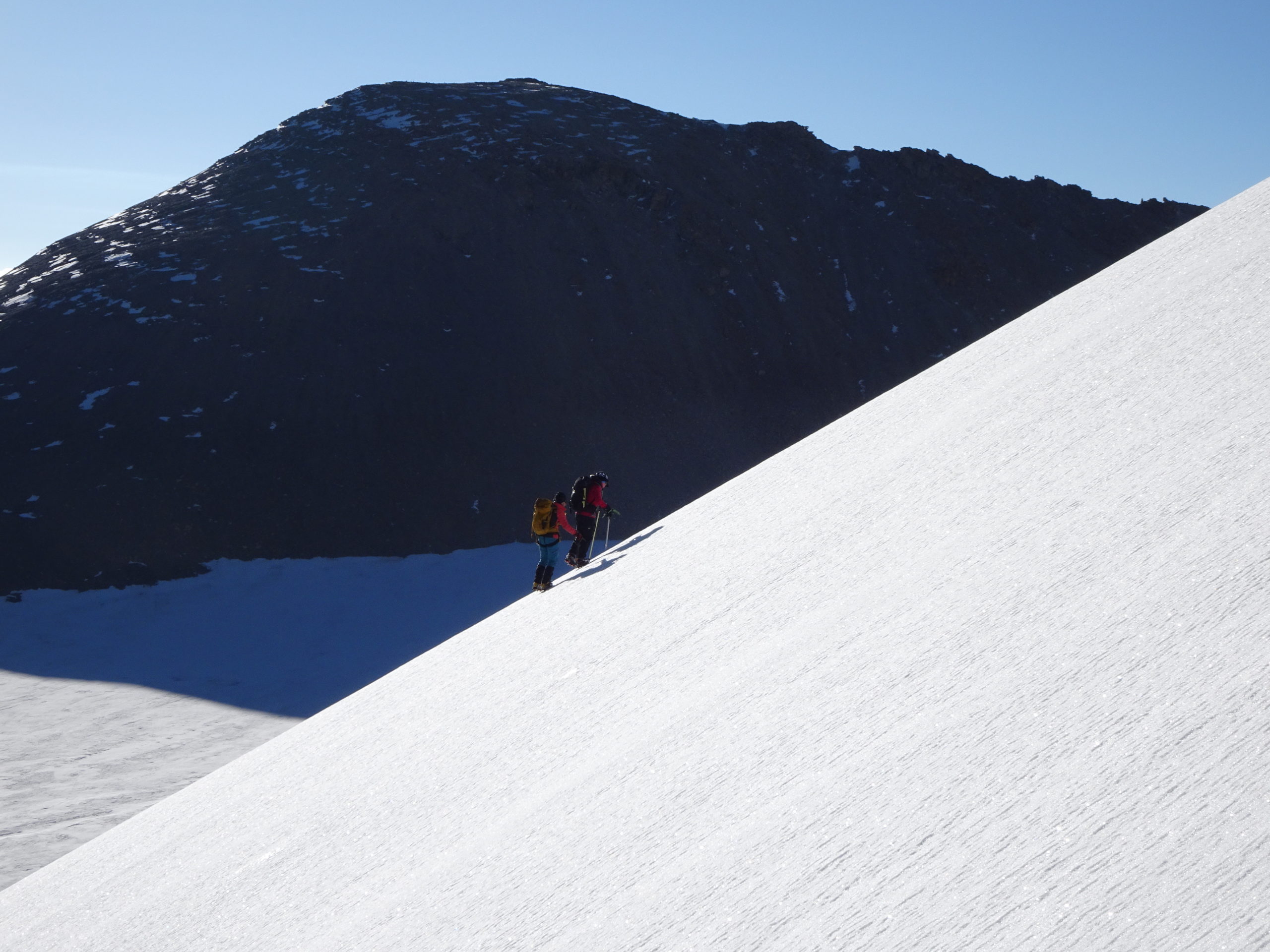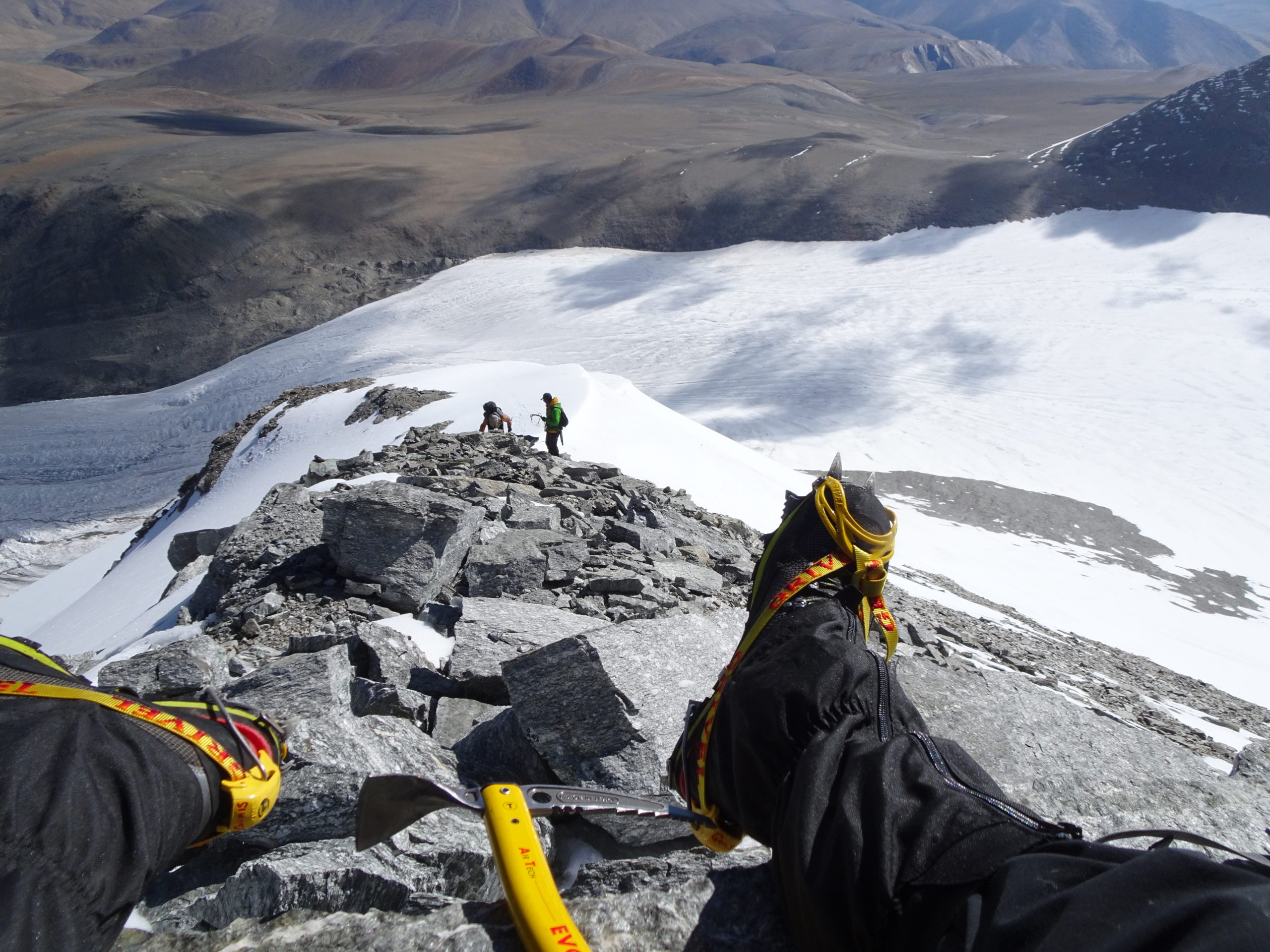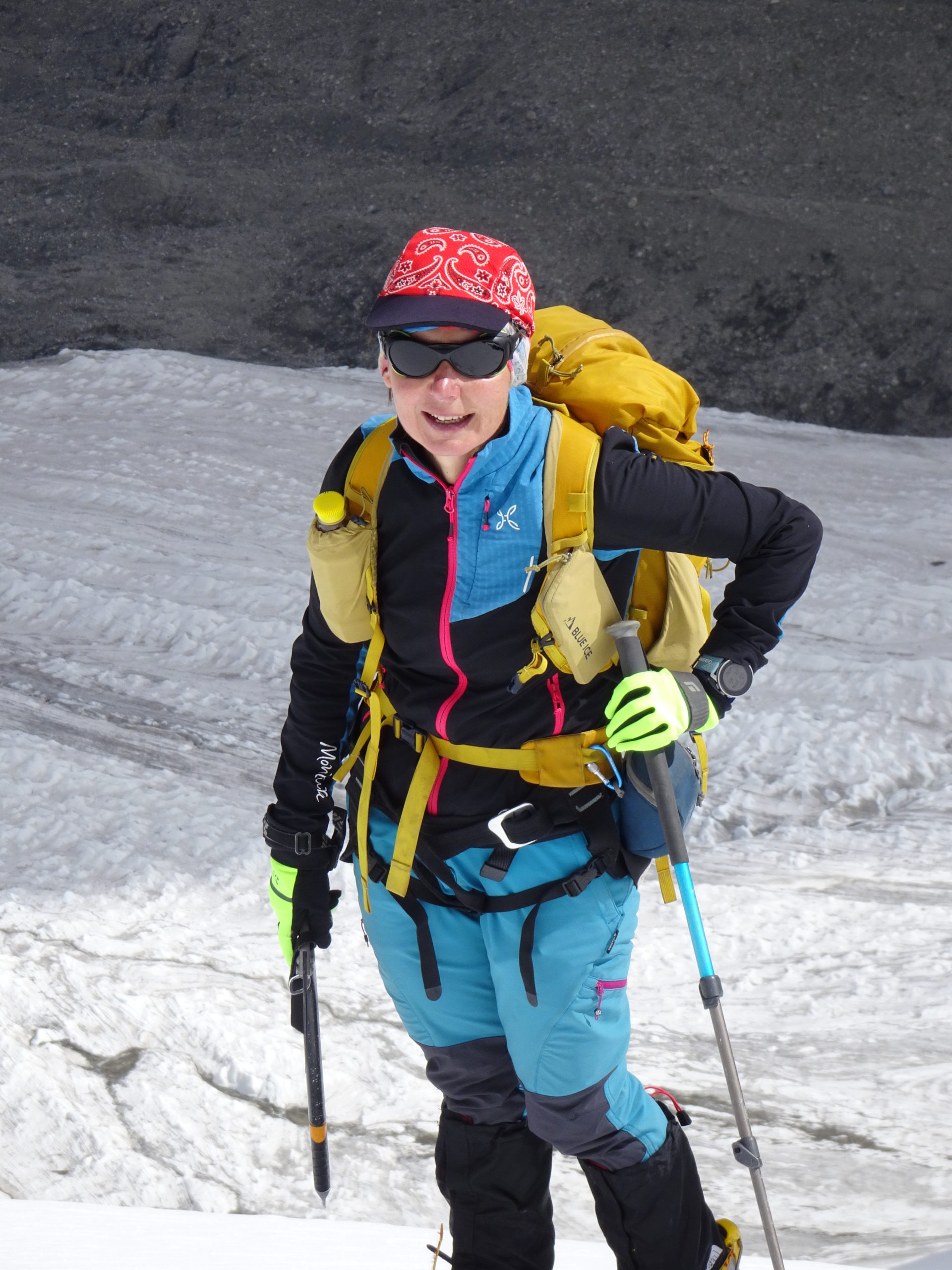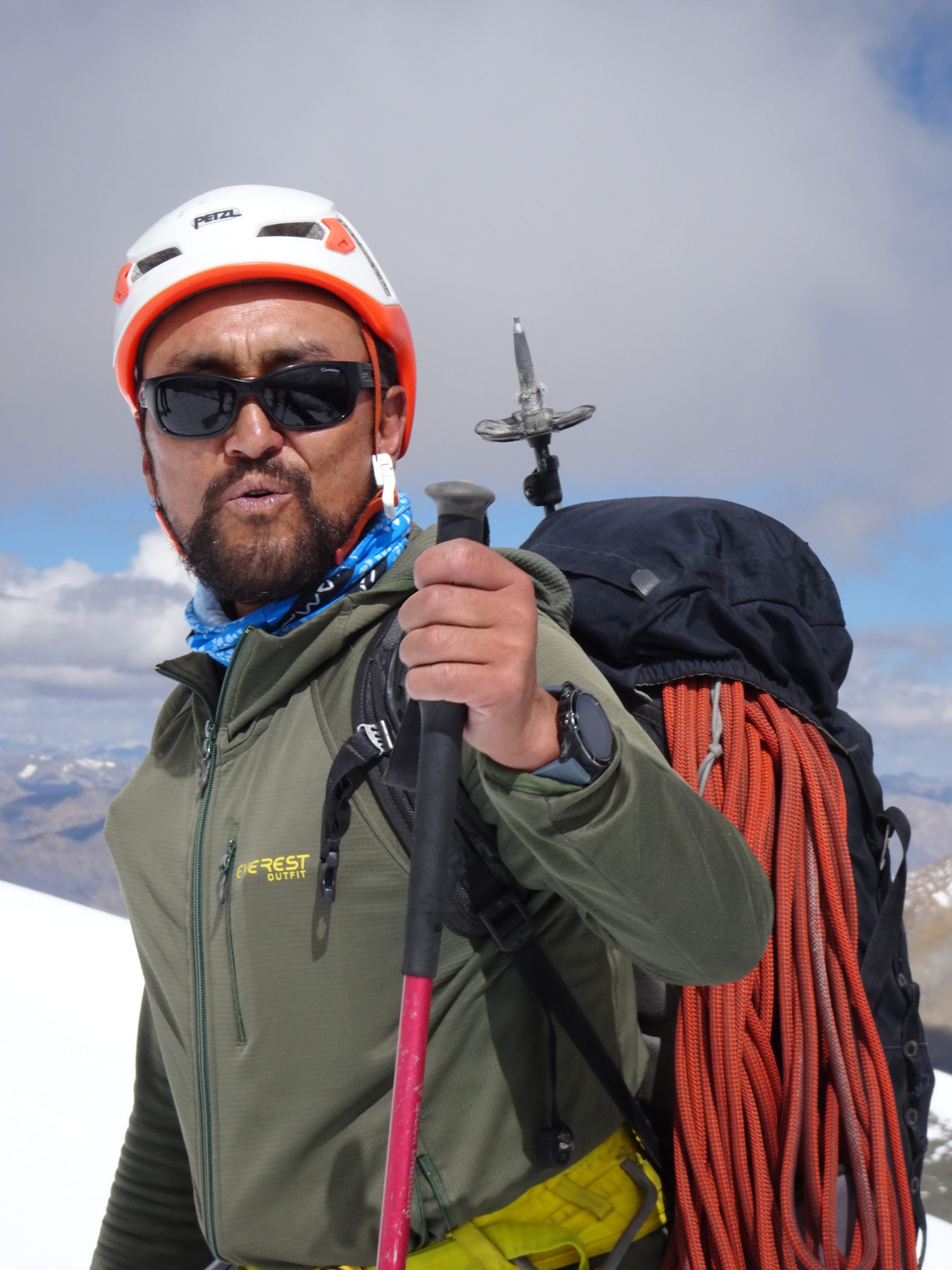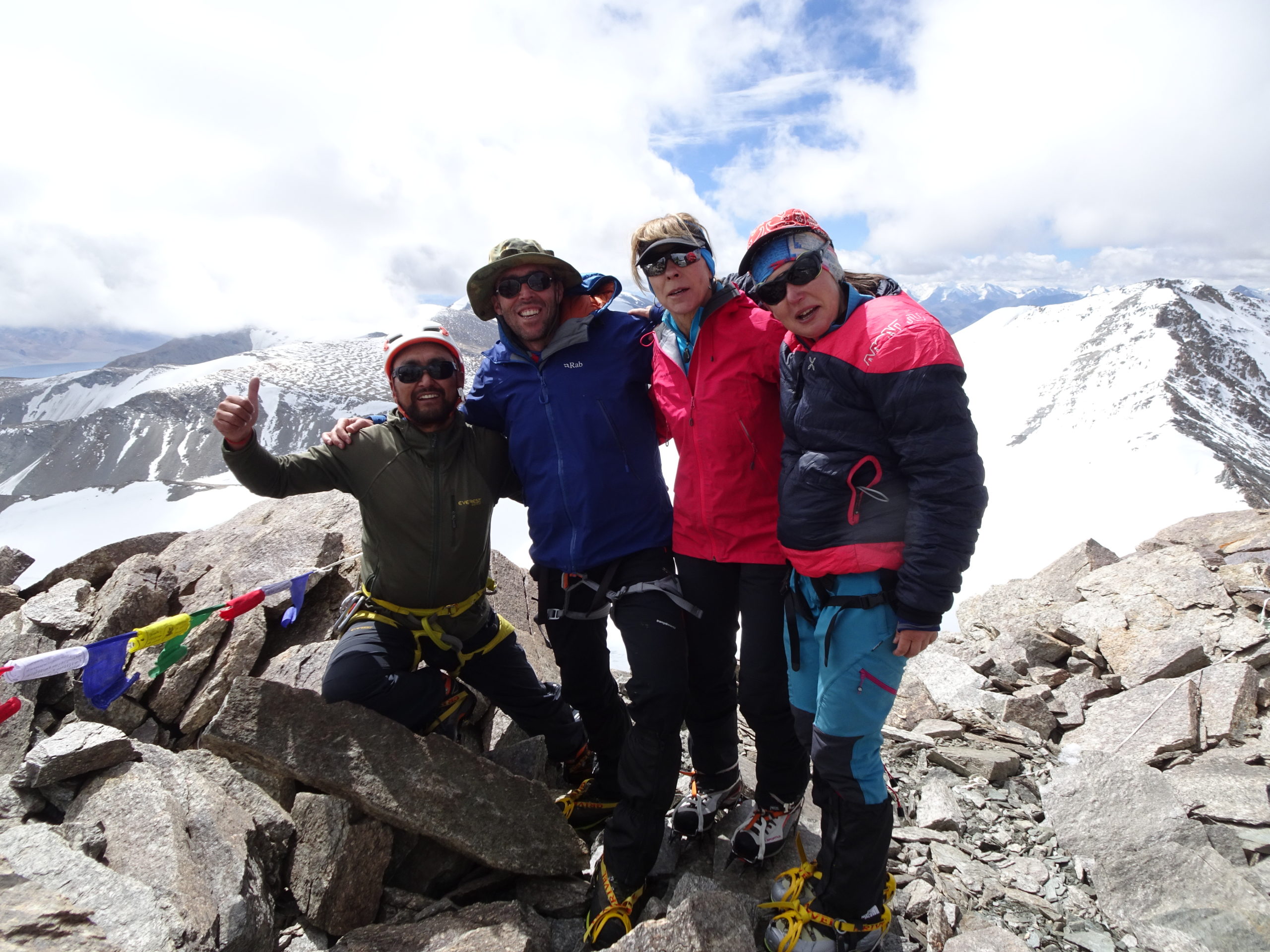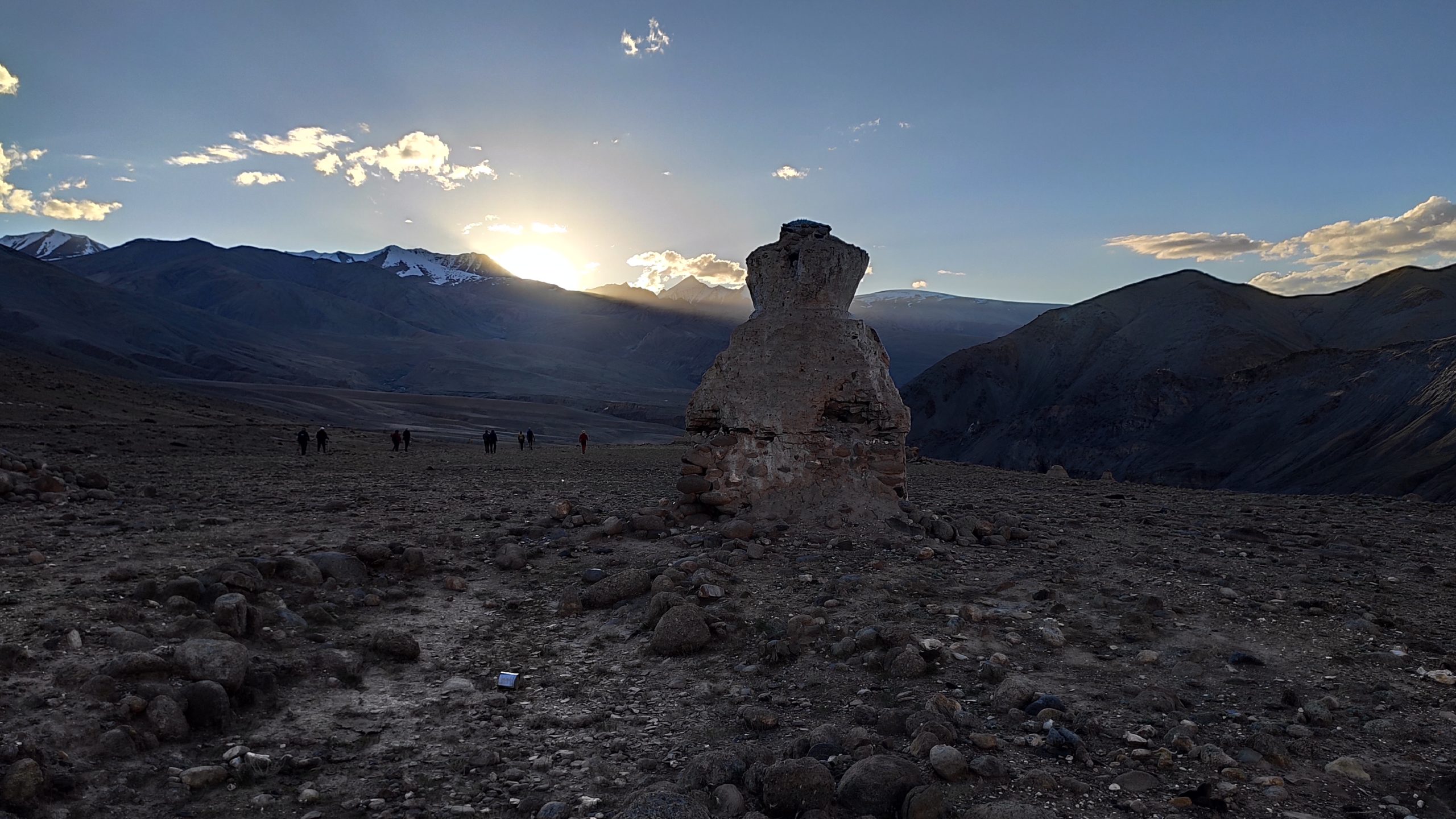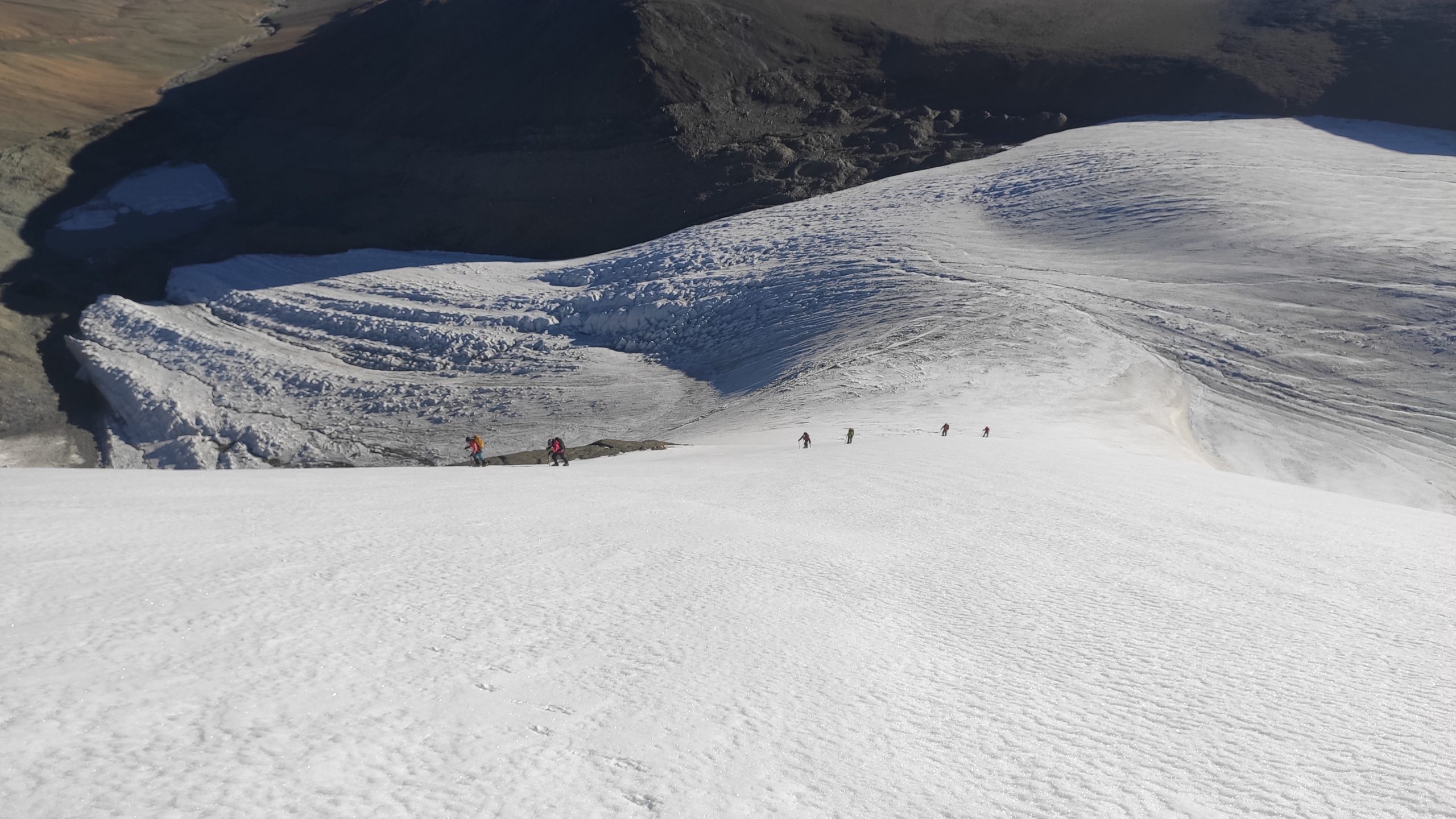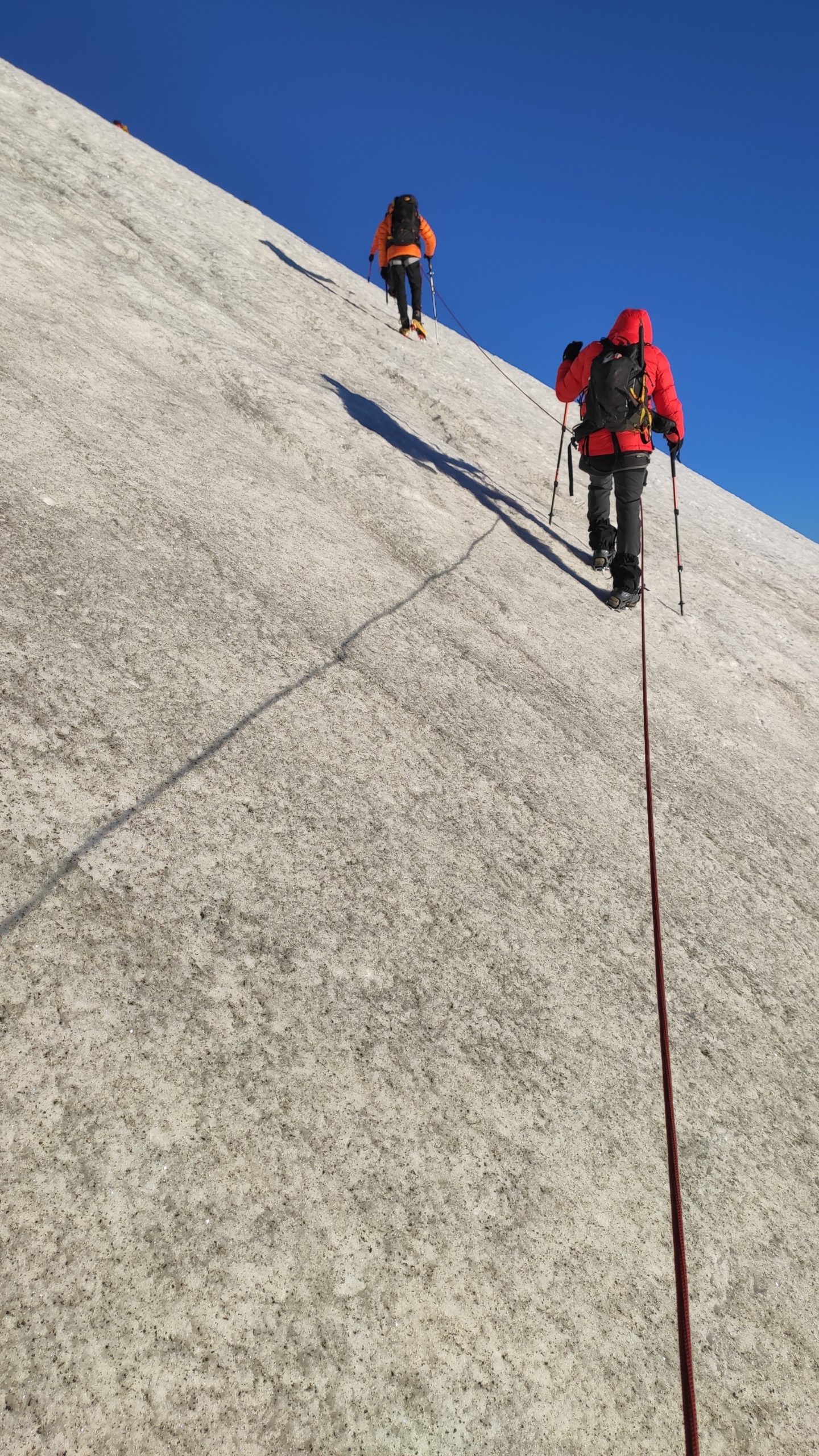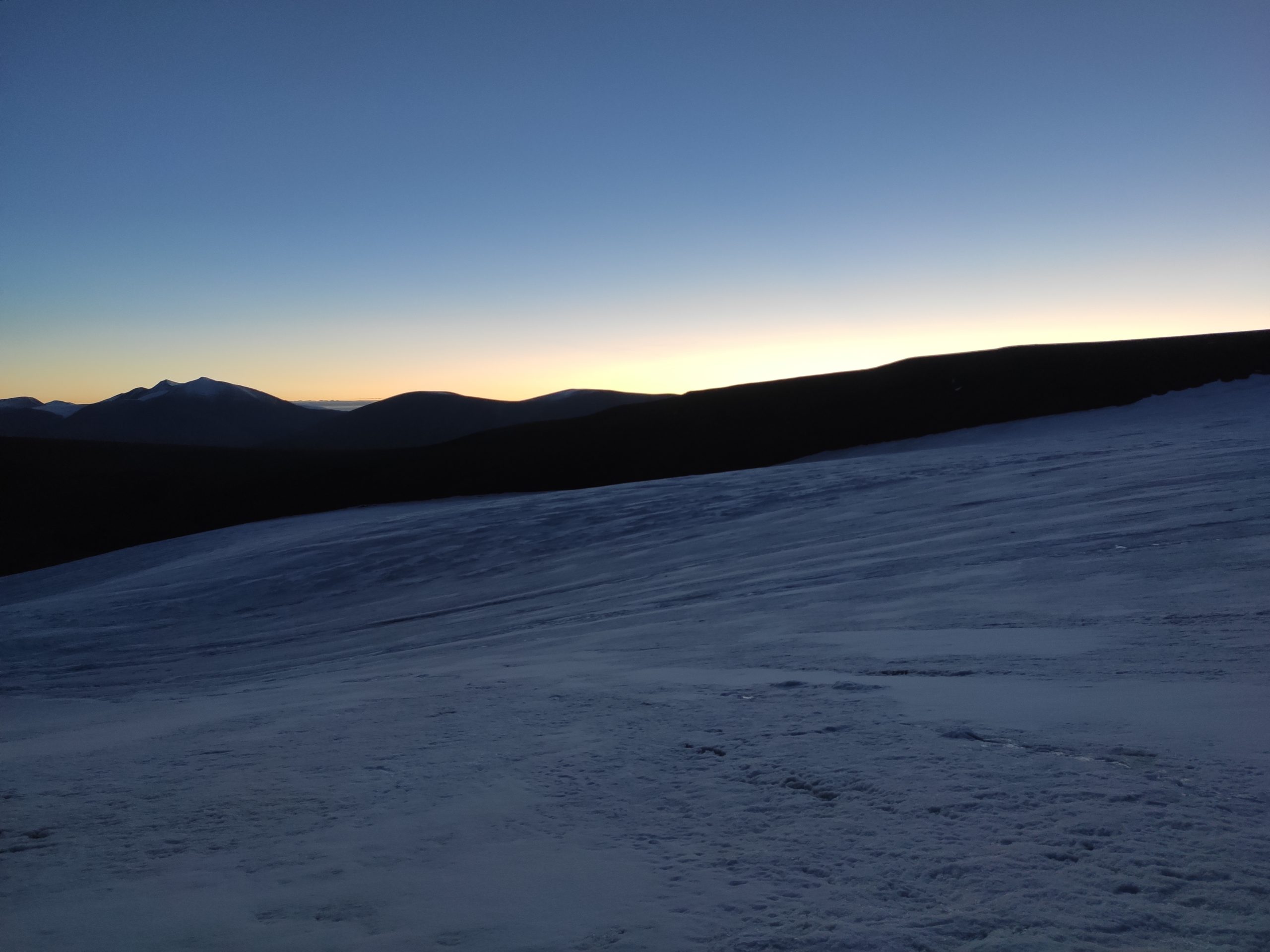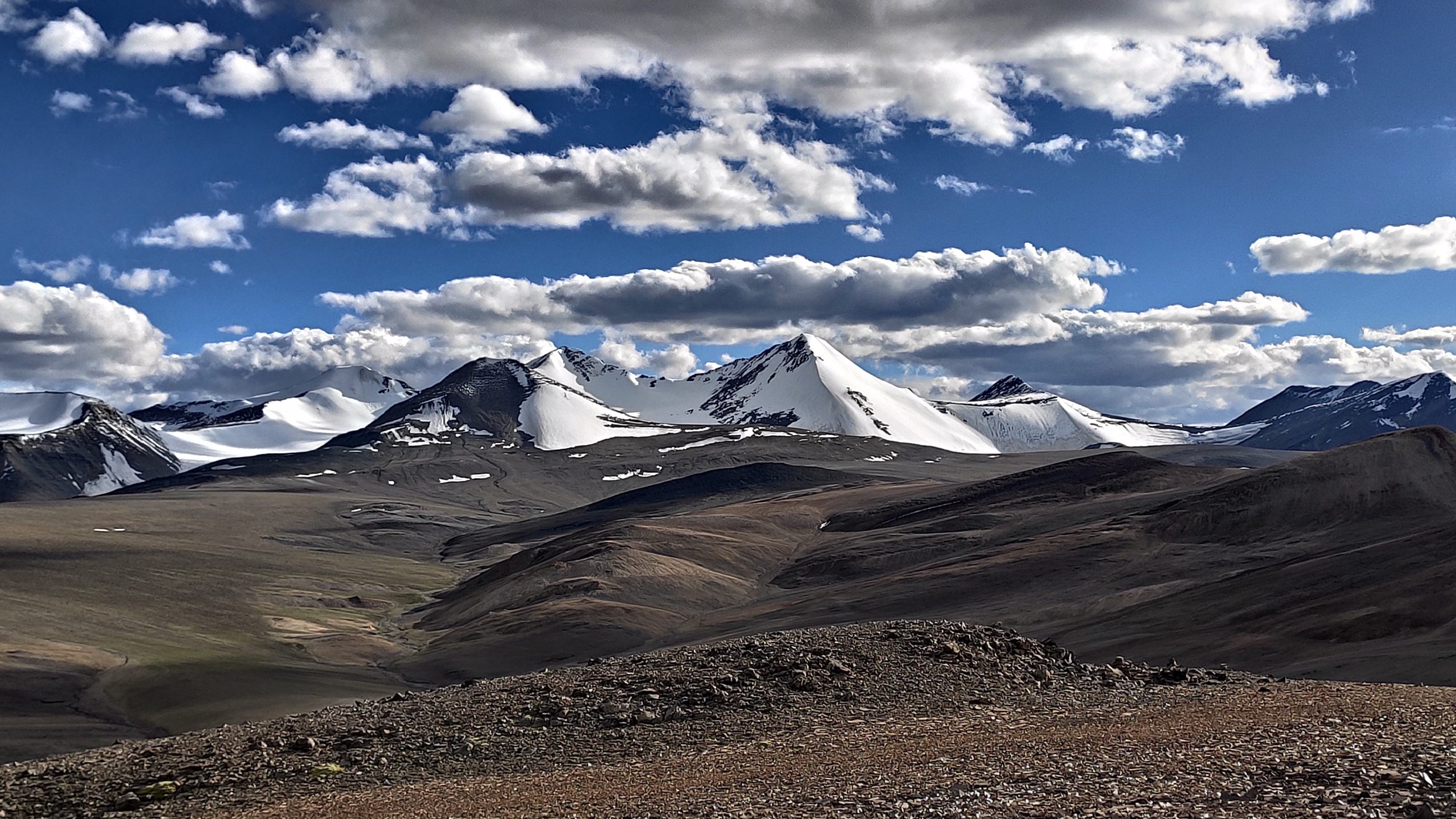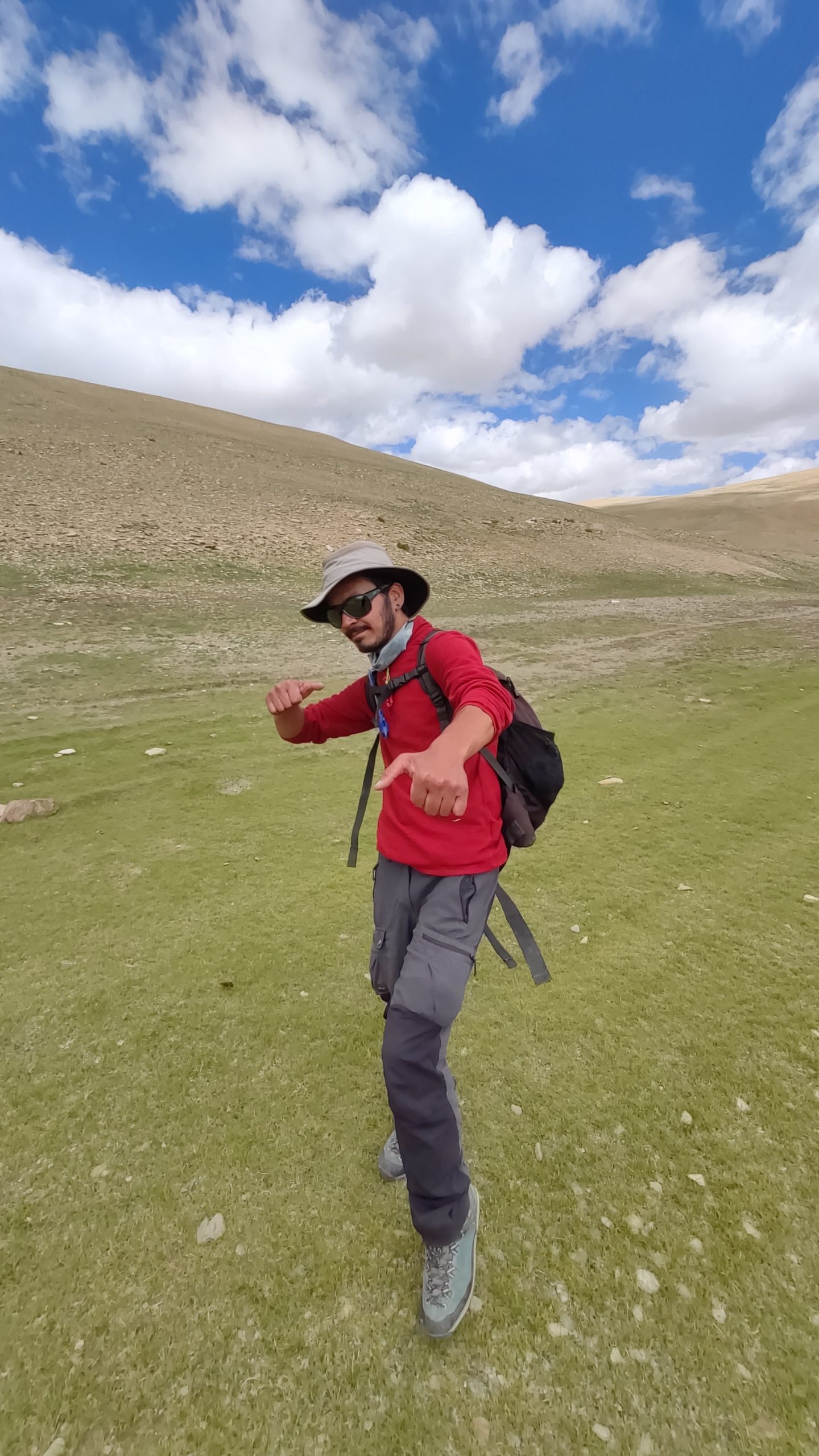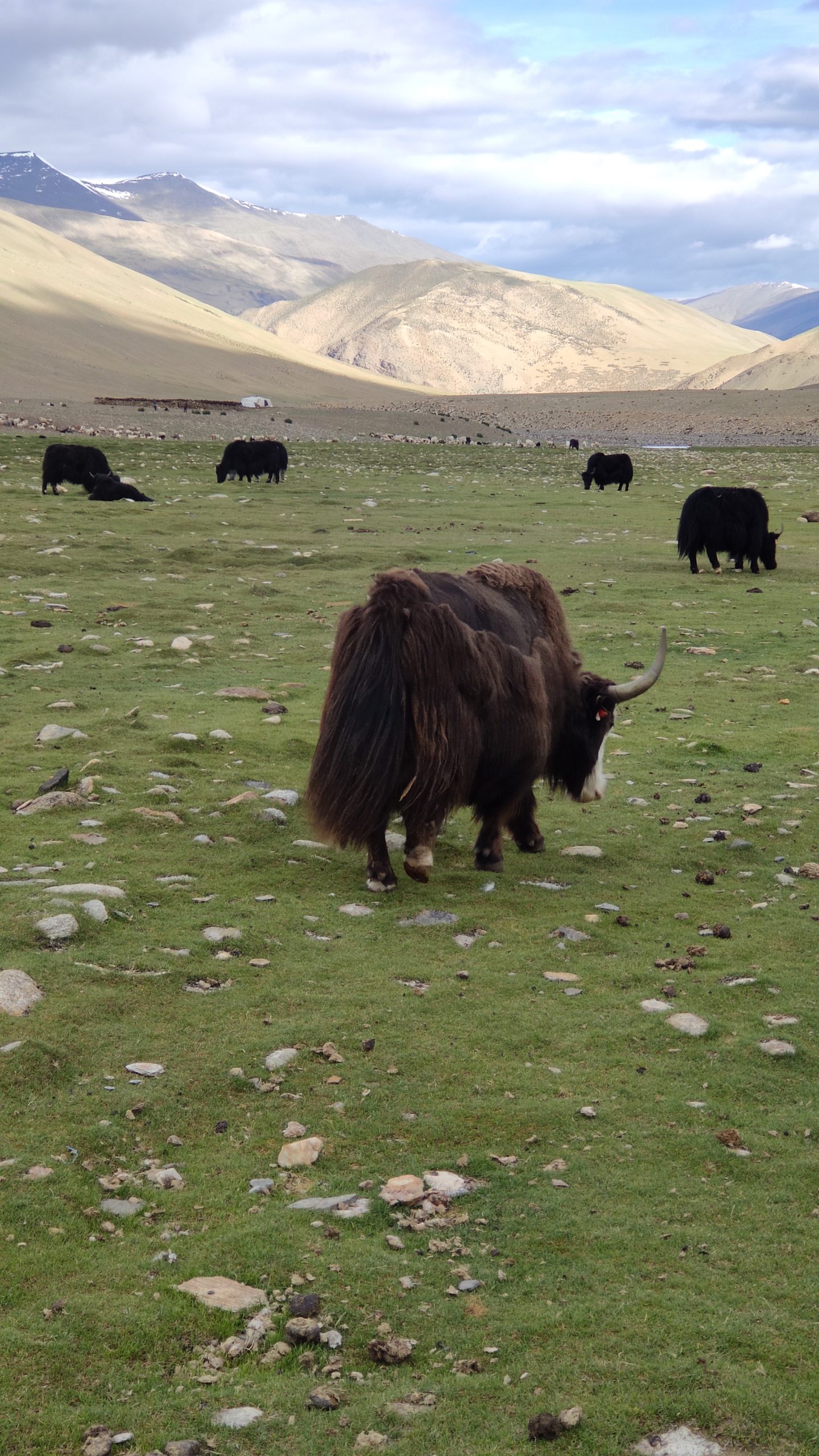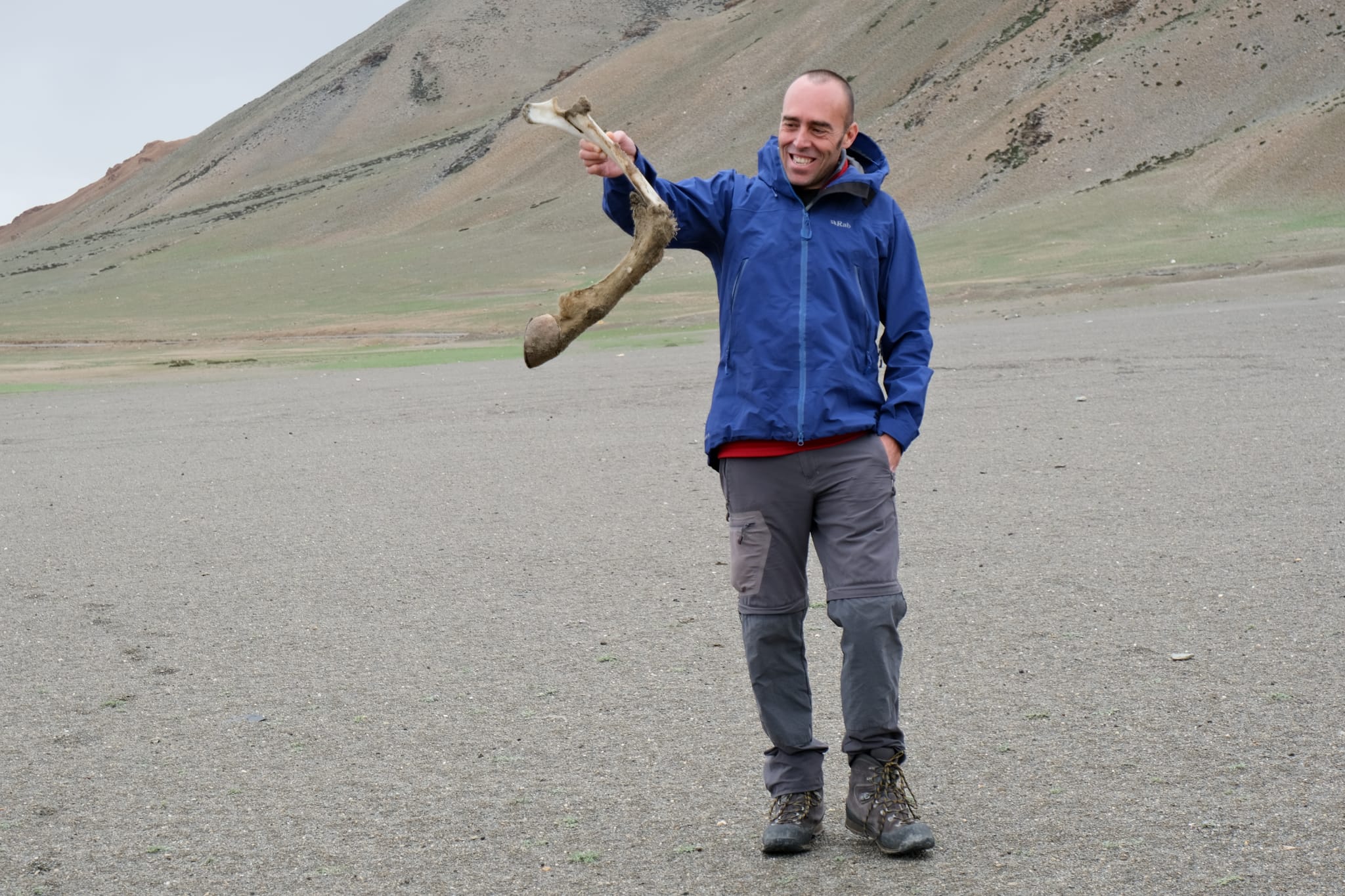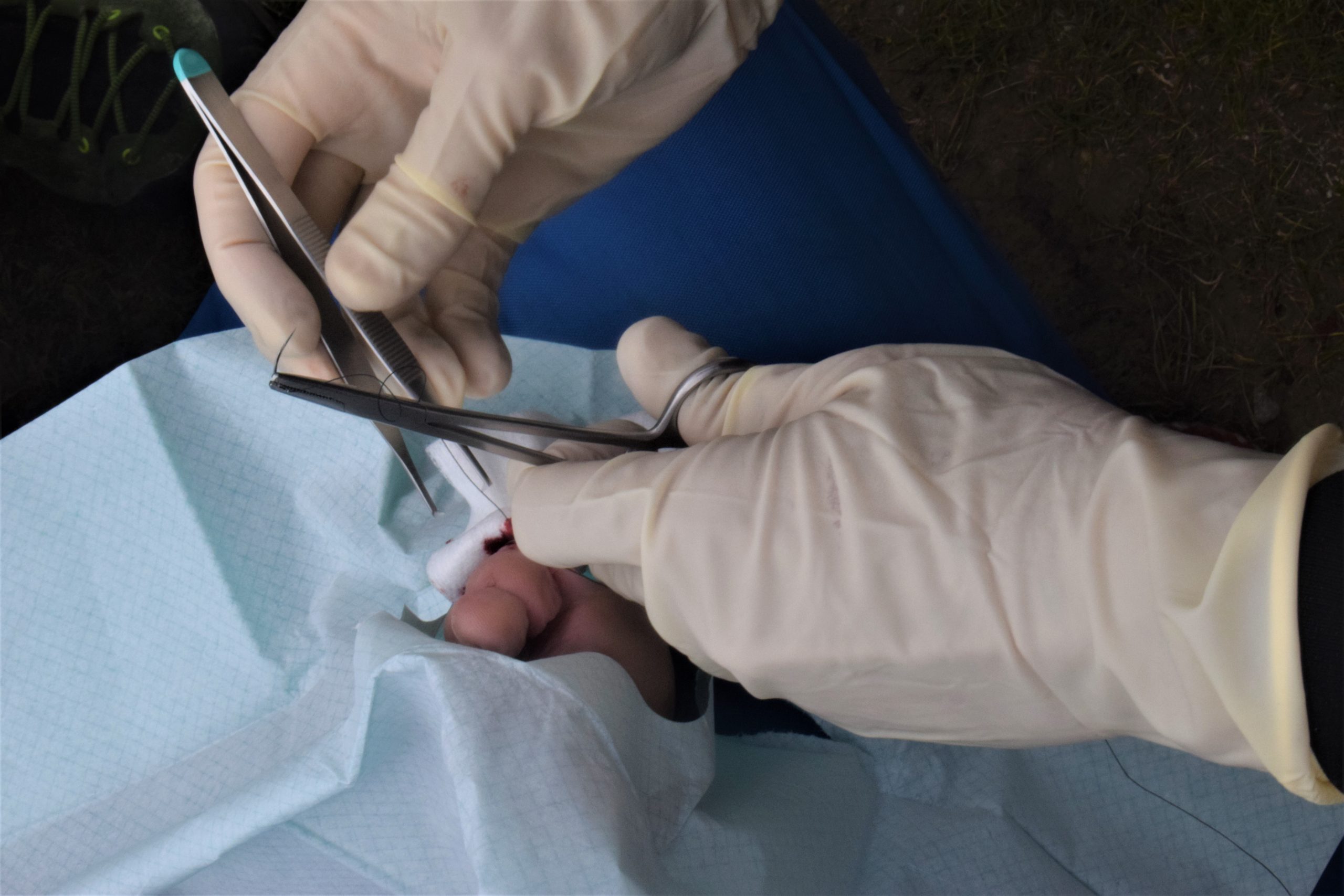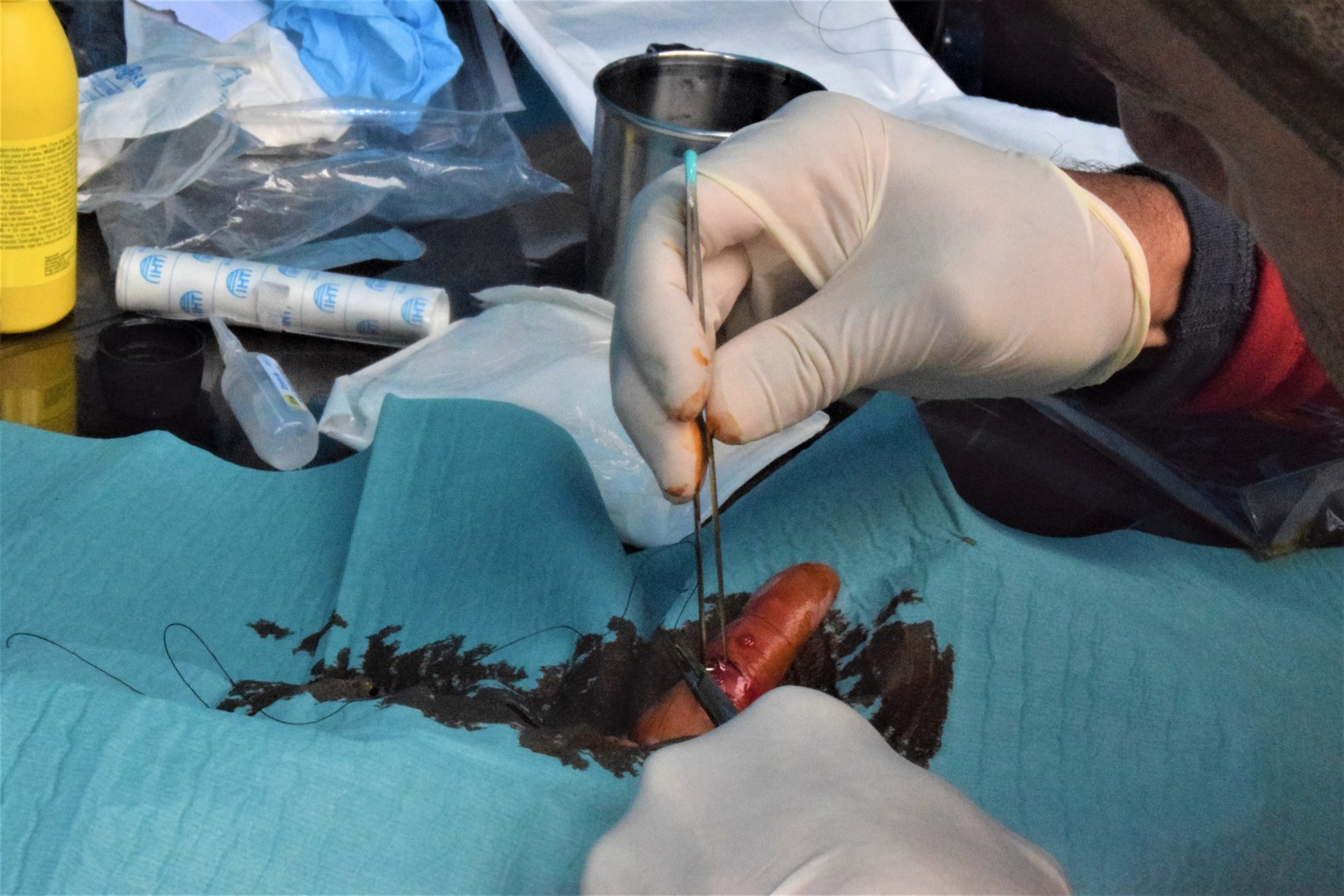Gyama Pyramid Kangri (6,300m) by Juan Gomis
Gyama Pyramid Kangri (Gyama North) Juliol – August 2023
Text and photos by Juan Gomis Ferraz
It is an absolutely remote peak located in the KORZOK mountain range, in the region of Ladakh in the Indian Himalayas. It is just 40 km from the Xinjiang border and about 200 km south-east of Karakorum, between the Tso Kar and Tso Moriri lakes.
Geographically the area corresponds to the western sector of the Tibetan high plateau in the Chang Tang region. It is very little travelled, with no roads or villages. Some nomadic shepherds came from Tibet with their herds of goats and yaks, but they were only present during the first days of the expeditions. After that, there were only valleys, rivers and passes over five thousand meters high flanked by peaks of over four thousand meters at first, then five thousand and at the end six thousand meters, with peaks, many slopes and no names.
The expedition is a journey of several days through remote and uninhabited areas, and while we are getting into the succession of valleys and passes, we notice the isolation, which becomes complete during the days before and after the ascent. No mobile phone coverage, no satellite phones (forbidden in India), no Internet.
Arrival and acclimatization
We arrived in Leh, capital of Ladakh, at 3,500 meters above sea level on the banks of the Indus River. There we will be acclimatizing, doing the last shopping and visiting monasteries.
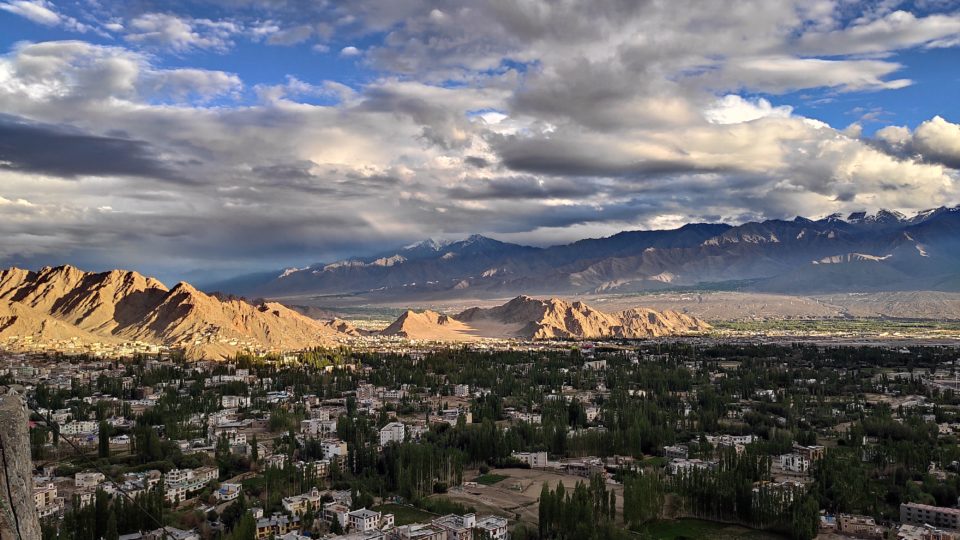
From Leh, a journey of more than a hundred kilometers by minibus awaits us by road that connects Leh with Menali, in the south, and that will take us to Rumtse, at 4,200 meters above sea level. The road starts to climb until we reach the top of the Taglang La or Tanglang La pass at 5,328 m (33°30’28.0 “N 77°46’12.0 “E). From the pass we climb to a small peak, Tanglang Ri, at 5359 m. Then we arrive at TSO KAR (White Lake) and from there to Nuruchen. Once there, after setting up camp, we decided to make an afternoon ascent to the surrounding peaks. It is an elongated mountain with three peaks and with bunkers from the 1962 war on the summits: Nuruchen Ri Sud, 4904 m. (33.205049, 78.008944), Nuruchen Ri Central, 4840 m. (33.221174, 78.005651) and Nuruchen Ri Nord, 4919 m. (33.246175, 78.001308)

Approach
We began to walk and over the next few days we came over higher and higher passes. The civilized world is over.
We reached the pass of Horlam Kongka La at 4970 m. What a view. We climb to the surrounding peaks up to 5200m. Unnamed peaks surround us all around. We suffer some medical leaves in the team, one injured in a foot after crossing a river and two more with bad altitude. All three decided to retire.
The next day we arrived at the Katstse La pass, at 5,430 m. On the Guru Map App it appears badly with a different name (Kyamayuri La), as the guides indicate.
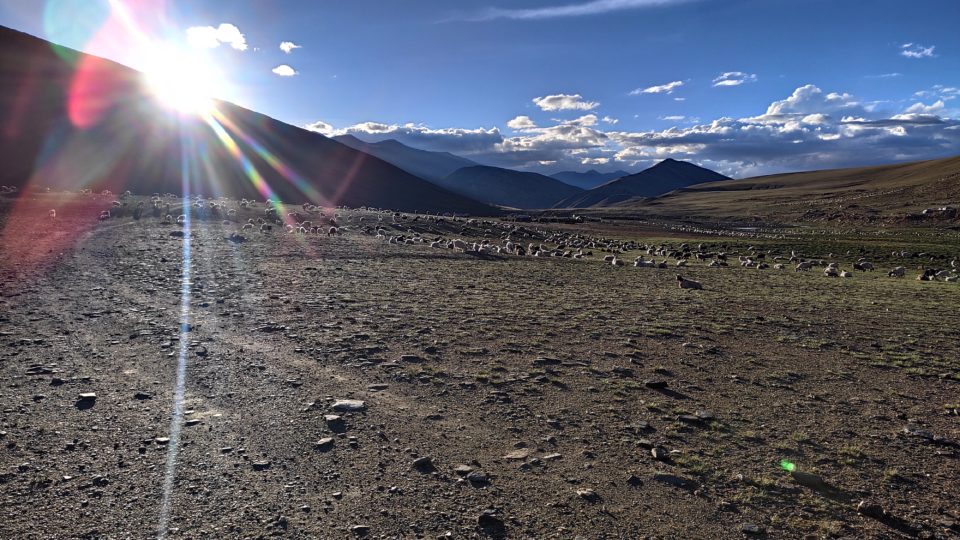

We rested for a while under the flags, the rest of the skulls of yaks, the goat banks and the mountain of stones left as an offering, some of them carved in Tibetan with the mantra “OM MANI PADME HUM”. And above all, far away you can see the pyramid of Gyama, our destination. Far, very far away, completely snowed, but you can already sense it. With the zoom you can see it more clearly. We change valley.
We leave Kanchung Karu and go down to Gyama Camp (Gyama Barma. 33.163860, 78.083083). We enter a valley surrounded by snow-capped mountains and glaciers, and we find a large number of yaks grazing. Now you can really feel the true solitude of the place, only mountains and yaks.

Once again, a large river flows and we are snowed in again. We start walking again and the snow and the wind get worse. We walk for more than 15 km at altitudes of more than 5000m. We finally arrive at the camp. We put up our tents and we go inside. It is a very bad afternoon with wind, snow and cold. Everyone has a bit of altitude sickness and digestive problems, but nothing serious.

We wake up on the eighth day with a few clouds but no wind. We pick up the camp and, once again, there is another wound in one hand when we removed a pickaxe it with the metal spike. Well, two stitches and we get going.

We leave Gyama Barma and now it is time to go up another pass, Gyama Pass (on the map it appears as Kostse La) at 5,400m. It is starting to become more and more difficult to climb the passes. After descending it is time to cross another river again to head for the next valley, which is much narrower and less windy. Very tight. Finally, following the river, we reach a larger area where we set up our tents. We are at Gyama Base Camp I at 5,350 m. (33.038460, 78.168027).

The weather is very unpredictable, with sunny spells and brief thunderstorms. After resting and having a few cups of tea, and since the day has improved, we decided to climb a peak that can be seen from the camp to the west. The Yualong Nyau Ri of 5,627 m. From the summit we have an impressive view of the surroundings. To the north, the Yalung Nong South of 6.090 m, to the south of the pass where we will return from the summit in 3 days, the Yualong Nyau La, and behind the pass, the Tsomoriri lake and Karzok, the village where the trek ends. To the southeast, the Mentok I, II and III mountain range of more than 6000 m, and just to our side our objective, the Gyama Pyramid North Kangri of 6.300 m.

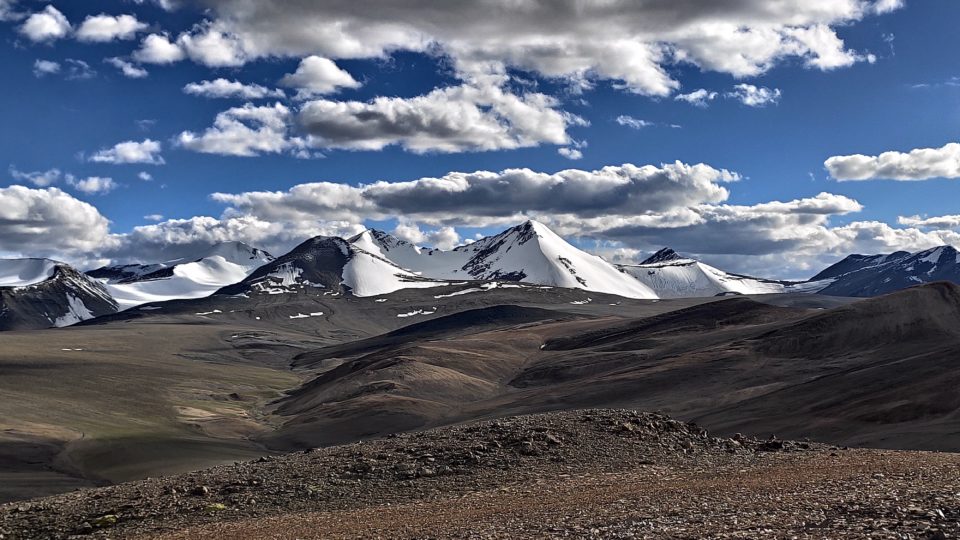
We now wake up on the ninth day. Today we go without pressure and little by little. We make a relatively short route to Gyama Base Camp II at 5,500 m. (33.008287, 78.159156). We prepare the bikes and the material. We adjust crampons, harnesses, ropes, headlamps, gloves…. Rigzin meets us and gives us instructions for the following day.
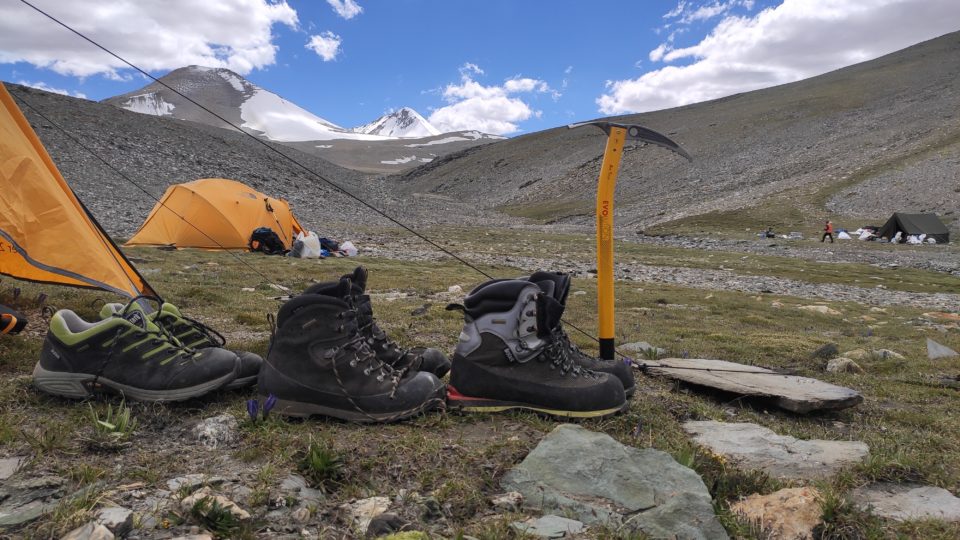
Rest, reading and meditation. Contained emotion and anxiety. Uncertainties and fears. Sleep lightly and go to sleep early, even in the daytime. It’s time to get up, the summit awaits us.
Ascent
The 1st of August 2023, finally the moment has arrived. Clear night with no wind and no cold. 01:30 h. After a quick lunch, we get ready, a brief briefing and we start the march, with the frontals we go up to the rocky slope that descends from Korzok Ri (6.094 m.). We advance through an immense rocky area with all the silt and frozen rivers. After a few hours, we arrive at the top of the final peak that coincides with the slopes of Korzok Ri and which is no more and no less than a gigantic lateral moraine of the glacier that descends from the Gyamas chain… and that we have to climb. The truth is that it was unexpected, as it is such a remote and infrequent summit and there was no graphic information either in books or on the Internet, just a couple of photos with which we speculated about the sides, the ridge, the slope, etc., but nothing about the glacier.
We start to descend the moraines down to the gel and there we put on our crampons and we string ourselves up.
We made three ropes. Queralt, Almudena, María José and Rafa, on one side; Tundup, Manel and Jordi on the other; Goyo, Vicens, Rigzin and me on the third. We start the climb approaching the ridge and then, doing “zeds”, we get to the north ridge. It starts to get lighter and we take a while to contemplate the marvelous spectacle.
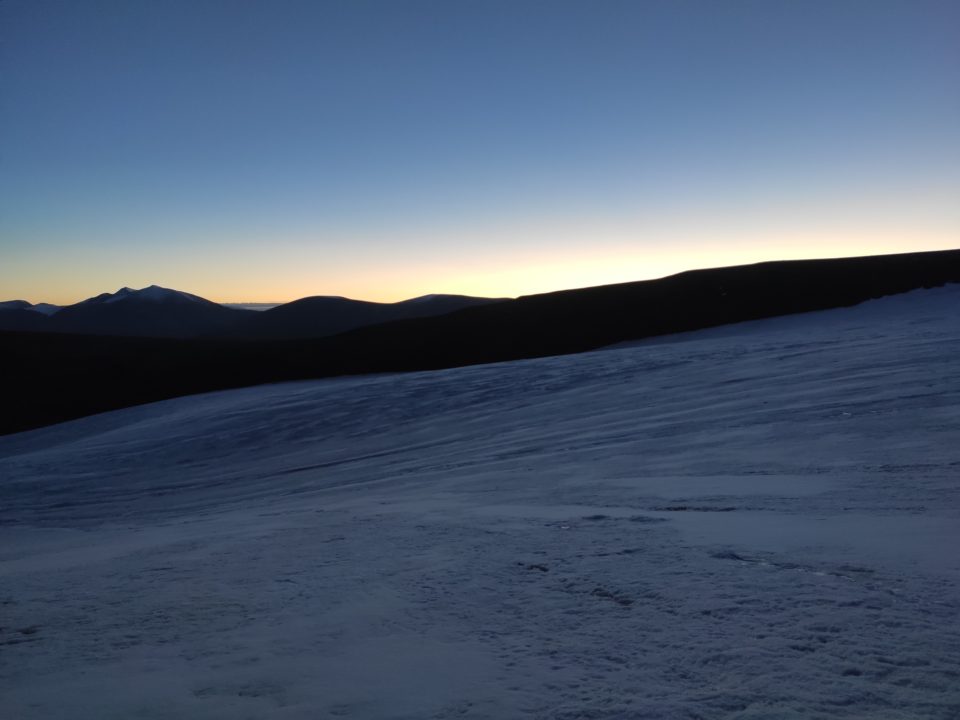
The effort is intense and considerable. 20 steps and we have to slow down to recover.
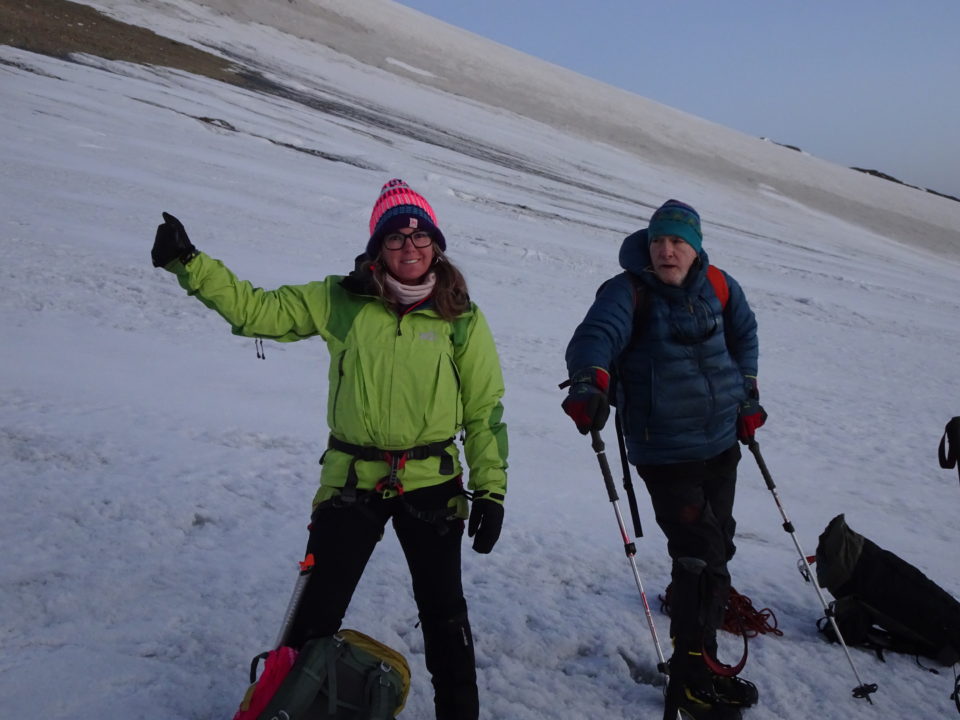
After an hour of climbing, two of the group begins to feel the altitude to the point of tying up and opting for the descent. We let the ropes down because of the good quality of the snow, hard without gel and the absence of skerries on the ridge. With sadness, we see those who have decided to go down descend and the rest, in the end, everyone climbs at their own pace. The women to the maximum.

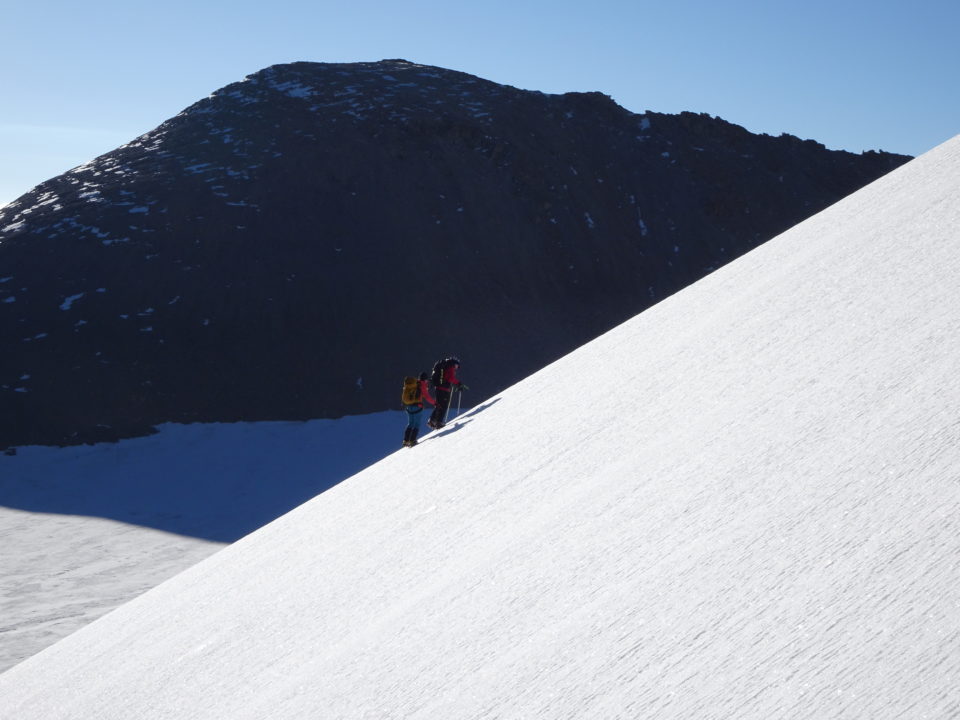
I look good. I went with Goyo and more or less we went at the same pace. We go up, and at 6.000 m. we rush to rest, some boiled potatoes and some hard caves in a highlight with the glacier in the back and a view that pulls you down. Queralt, María José and Almudena were good. The rest too, the two who were going down badly, almost at the terminal moraine, but we don’t see Jordi. Well, he is an expert in eight-thousands. We aren’t preoccupied at all. We continue climbing and 4 hours after starting the ascent we reach the summit. Goyo and I arrived together.
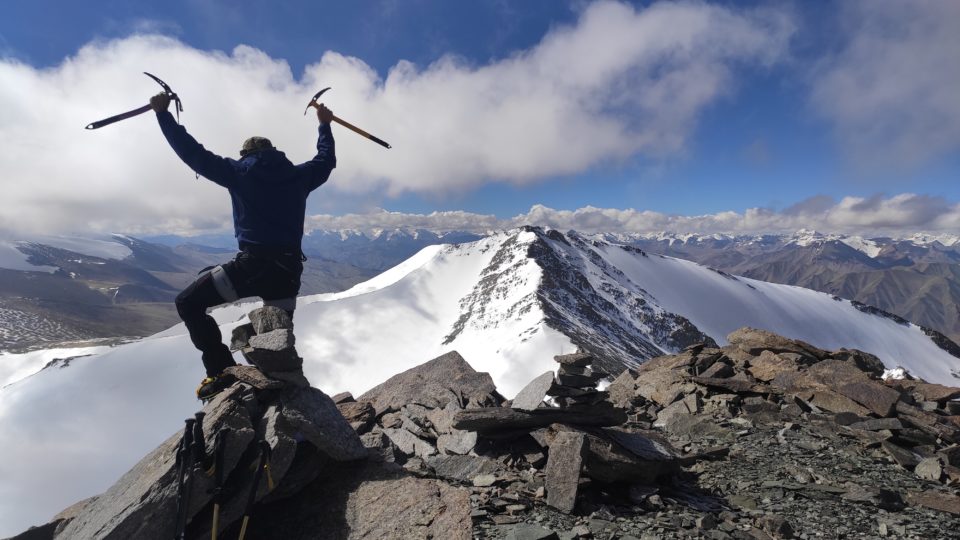
The first Spaniards to reach the summit according to the guides. And to make it even more satisfying, it is also my anniversary. 50 years. What could be a better present? IMPRESSIVE. Hugs, photos, congratulations and tears of emotion. What impressive views. The Karakorum covered by the clouds in the background, but the rest is impressive. All the Korzok mountain range, the Mentoks, the Shukule of 6.500 m., the Kun and the Nun of more than 7000 m. to the north-west and all the mountain range in Chinese territory to the east. We stayed on the summit for a while and the rest of the group appeared. All of us except Jordi, of whom no one knows anything. Very exciting the arrival of each one of us. Manel and Tundup were very emotional. The women were in very good shape too.
We opened some envelopes of black pork leg and some cervical chorizo to celebrate it. Big birthday celebration. And when we were almost out of pork, Jordi appeared and climbed up the north-west side, which was more free of snow, and that’s why he was able to climb better there.
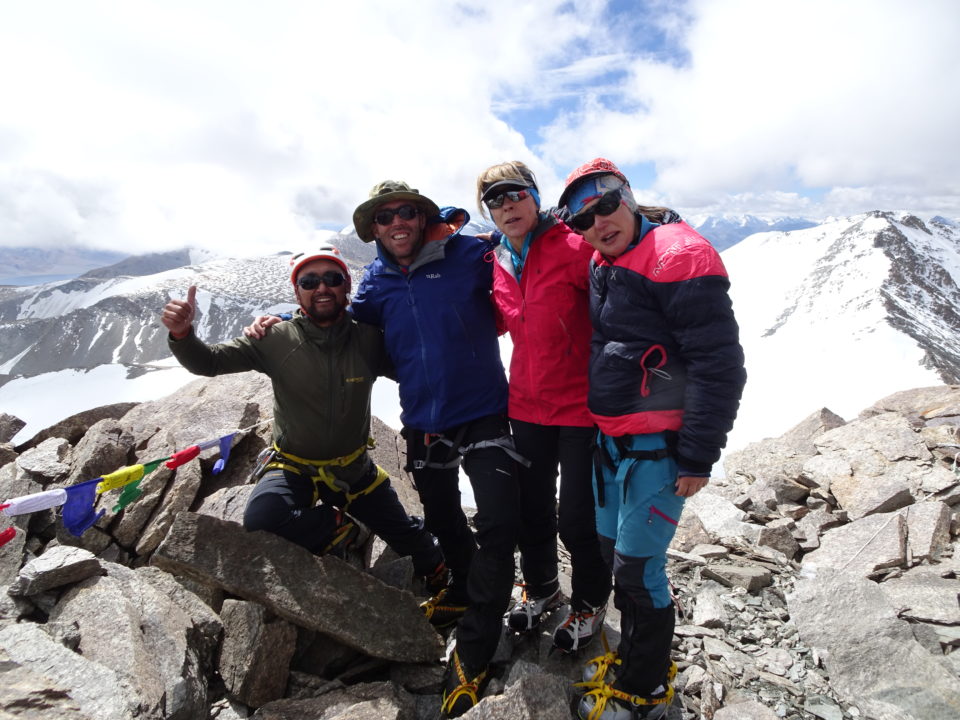
We remember those who stayed at the bottom the first days, those who had to climb halfway up and all those who have been waiting for news from home and who have given us support, encouragement and endurance during the whole year while we were preparing the expedition.
We start the descent; it takes several hours until we arrive at the moraine terminal.

It is hot and the water is already flowing, forming streams above and below the gel. We grouped up again to make it grow.
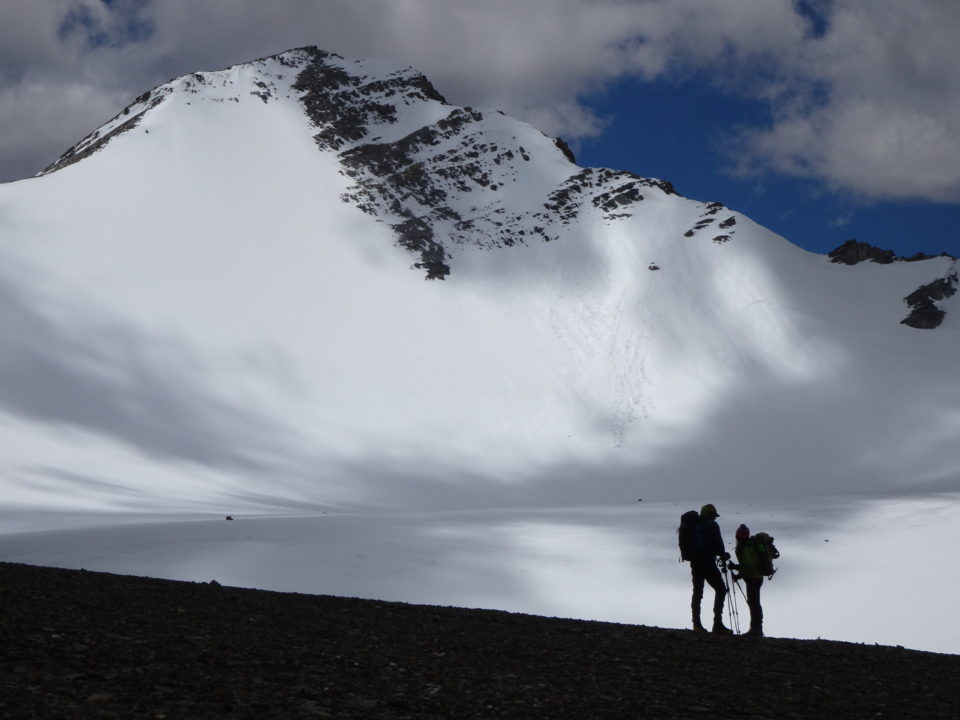
I would like to remember a 16-year-old cook’s helper who came up here from Camp II with a full pot of tea and some casseroles to offer us a hot cup of tea.


Little by little we went down and after a few hours we were at Base Camp II.
Throughout the afternoon the rest of the group appeared and the last of us appeared with the last lights. What a great satisfaction, all of us back safe and sound. We got together to have lunch and talk about the ascent, and for dessert the cooks had prepared an anniversary cake. Incredible celebration of 50th anniversary at 5.500 m of altitude. They had managed to cook a dessert, sponge cake, and some bread with a fork that they built with stones and mud and they cooked the dough by feeding it with dried peanuts and yak monkeys. INCREDIBLE. They even made a pastry crumb to decorate the cake. Simply BRUTAL. These people are at a different level.
The journey back
We pick up the camp and start to descend. We arrive at the Yalung Nyau La pass at 5440 m., which gives access to an arid and desert valley that goes down to Korzok. There are no rivers, nor almost no vegetation, nor shadows and after a few hours walking we settle in an area populated by nomadic shepherds. We opt for a small river that comes from the north (32.972934, 78.236143) with clear water and no animals to the top. We walk around the plain with the stupa, the flags and the yaks grazing. The next day we went down to Korzok and after 8 hours on the road we arrived in Leh.
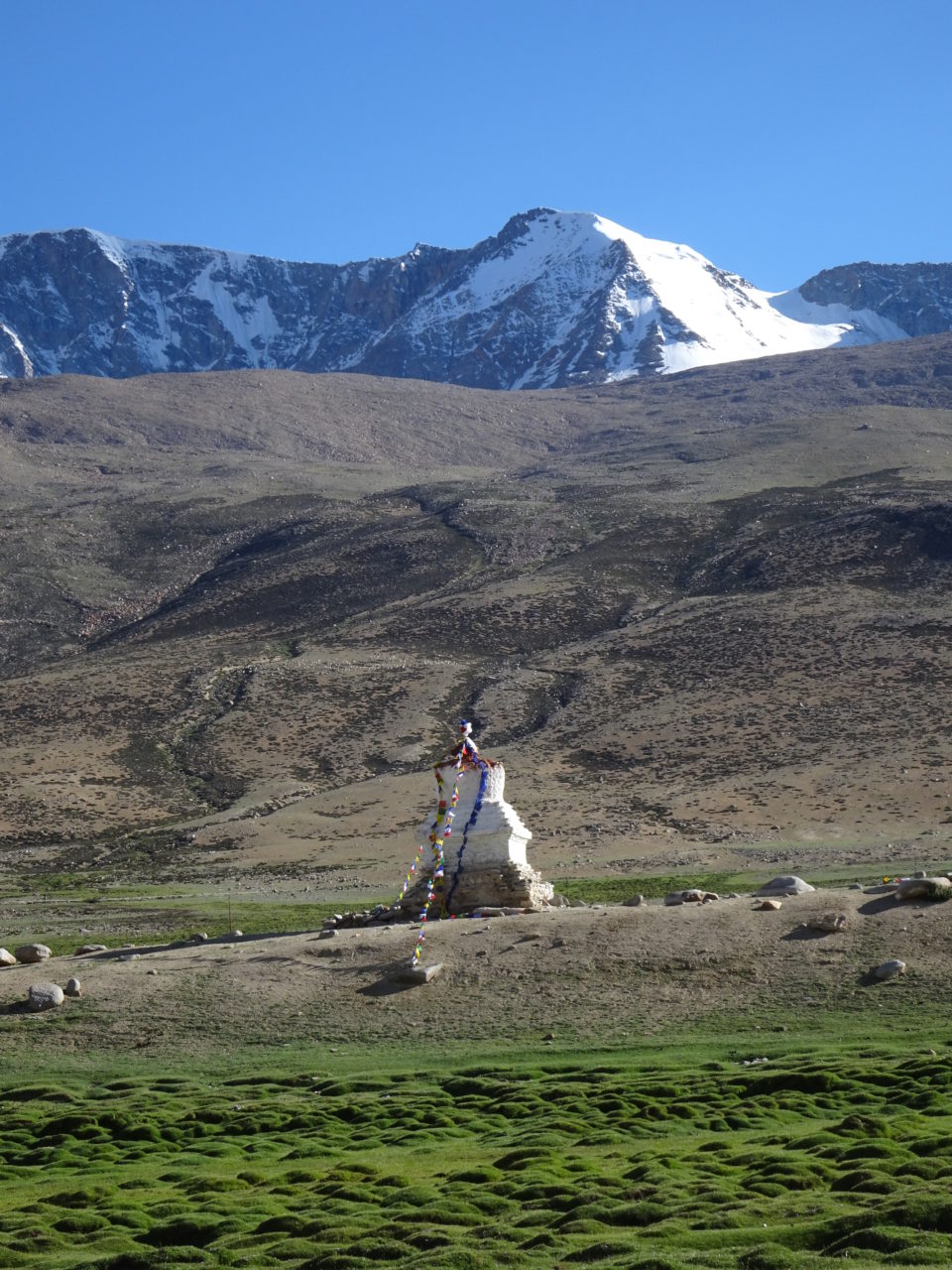
From the plane, half way from Leh to Delhi we can see the Himalayas in all their splendor.

Equipment
The footwear used on this expedition was Bestard in all variants.
Hiking shoes, Camí model for the acclimatization days, in the city and at the campsites after the day’s walk. Comfortable, versatile, waterproof and functional. Very resistant. A great shoe.
Trekking boots, model Kathmandu GTX, used during the long days of approaching the summit. Good grip with very good breathability and waterproof. Very comfortable and with a great result despite already being used a lot. They have withstood perfectly the long traverses, the rain, and the climb to five thousand without snow or just some snowfall. Despite the cold, it keeps your feet warm.
Rigid boots, Fitz Roy model, a great asset for the ascent to the summit of Gyama. Very comfortable even though they are high boots, without scratches or discomfort and a very good option for use in snow and ice, with perfect protection against cold at 6,300m. Very adaptable to both rock and snow and gel. It’s worth mentioning that they are almost as light as the Advance K Pro used in recent years in the Pyrenees and the Alps. I have used the Fitz Roy with the same results on Mount Ararat in 2021 and on Monte Rosa in 2020, as well as in winter in the Pyrenees and Terol.
Great products of high quality and comfort. No doubt I’ll continue with them in future adventures
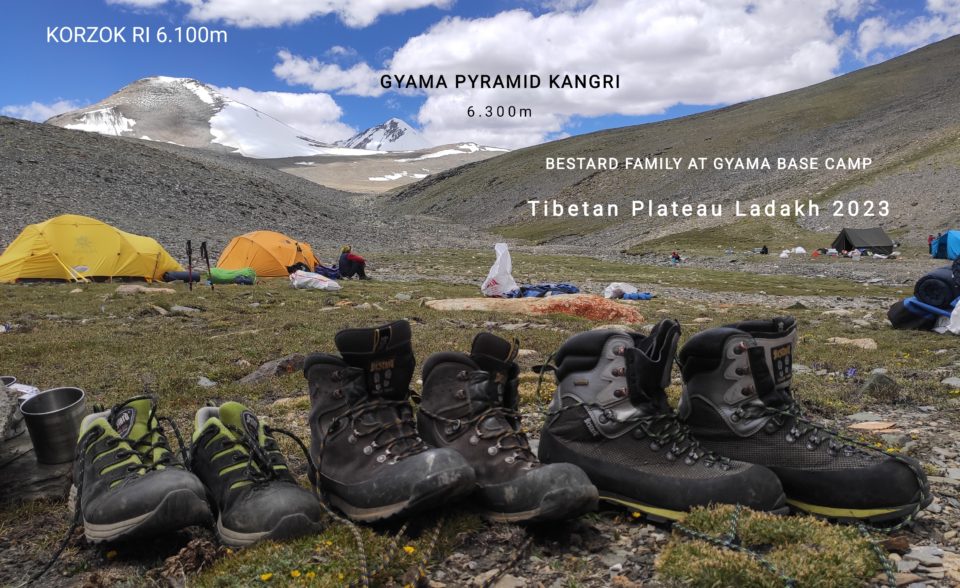
Juan Gomis Ferraz
He is a satisfied customer with our brand after many years and after contacting us we thought it was very interesting to share this story with all our followers.
